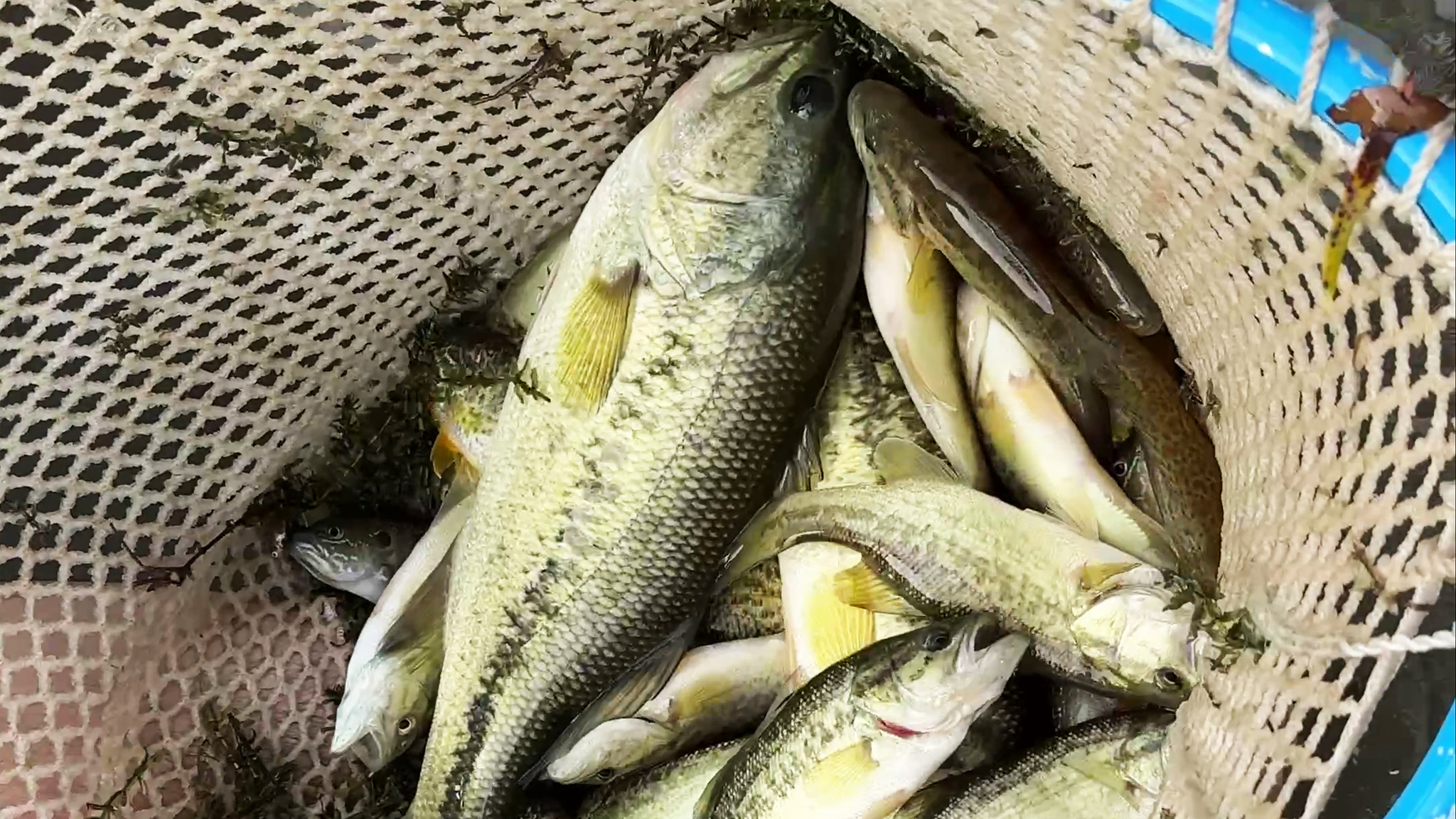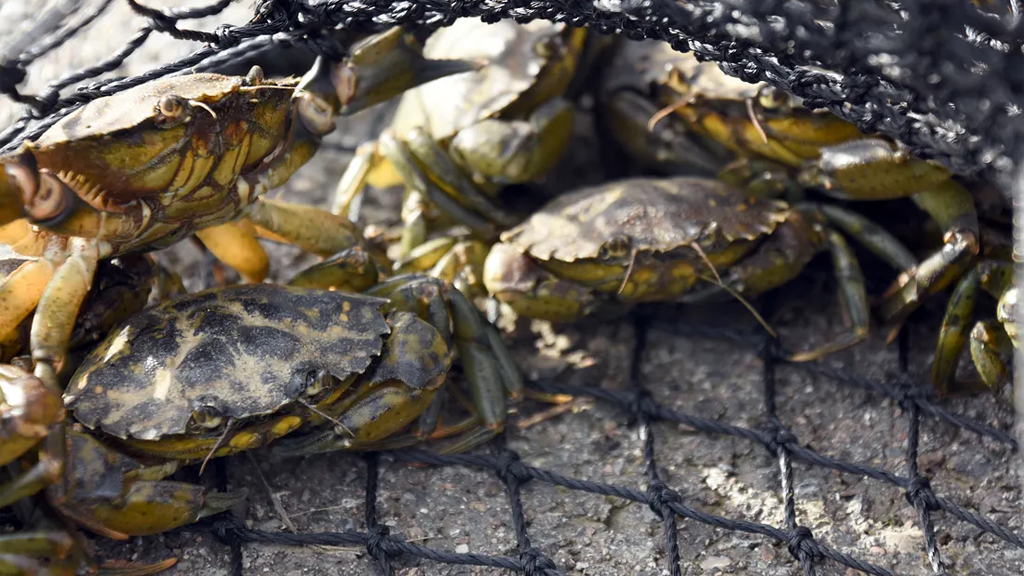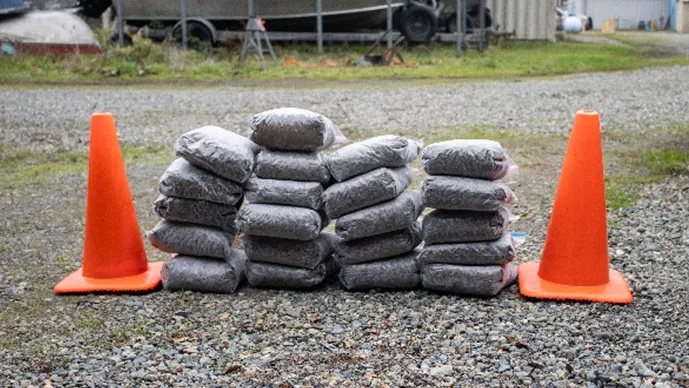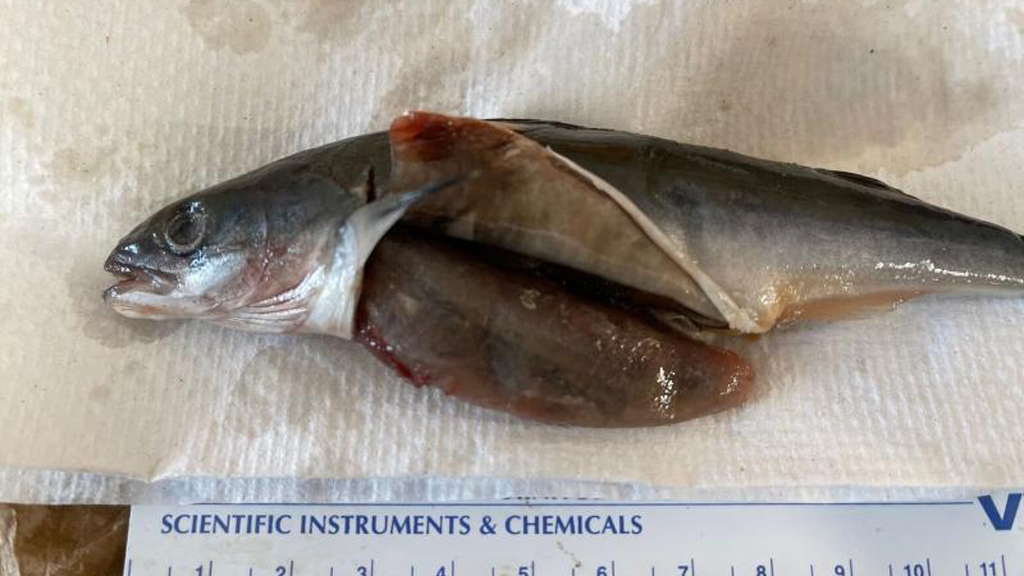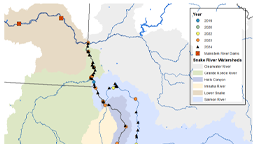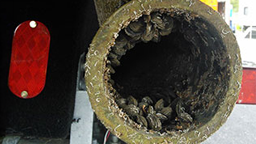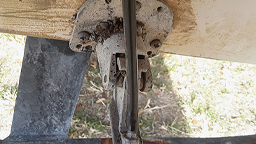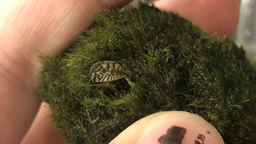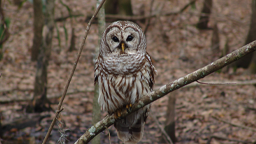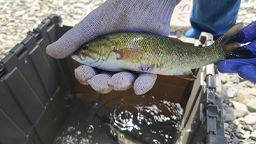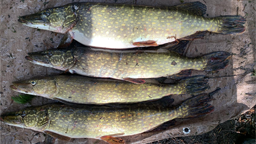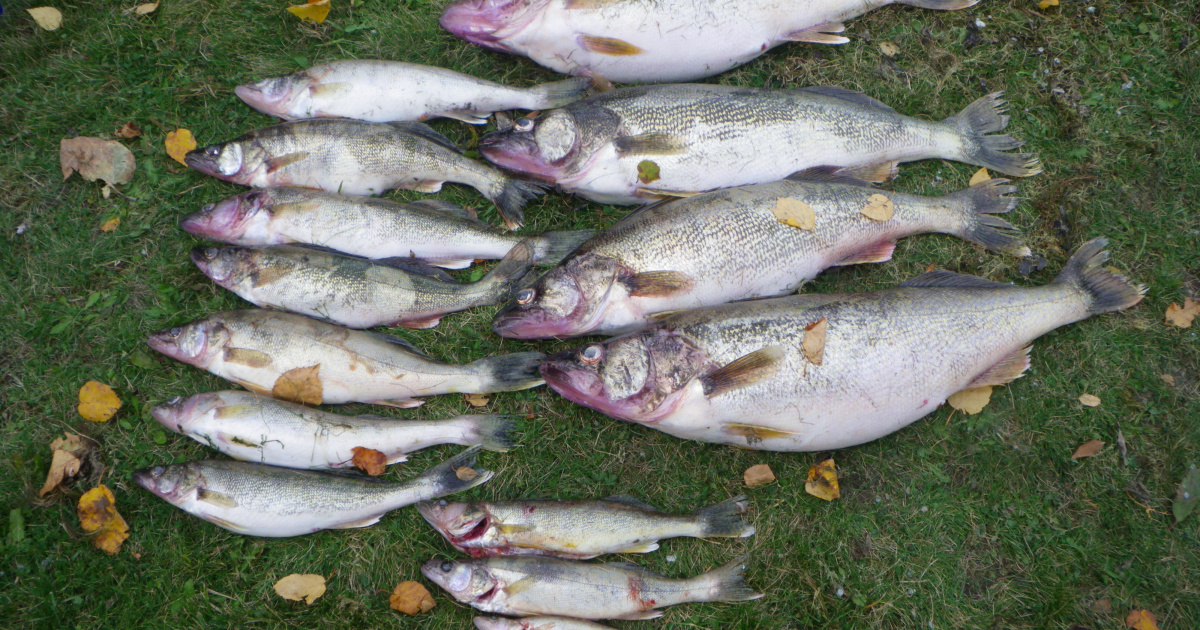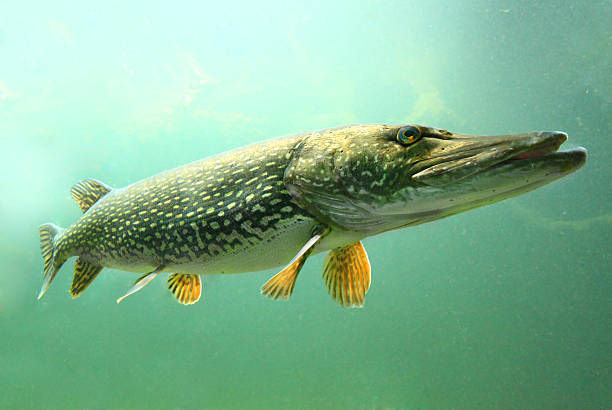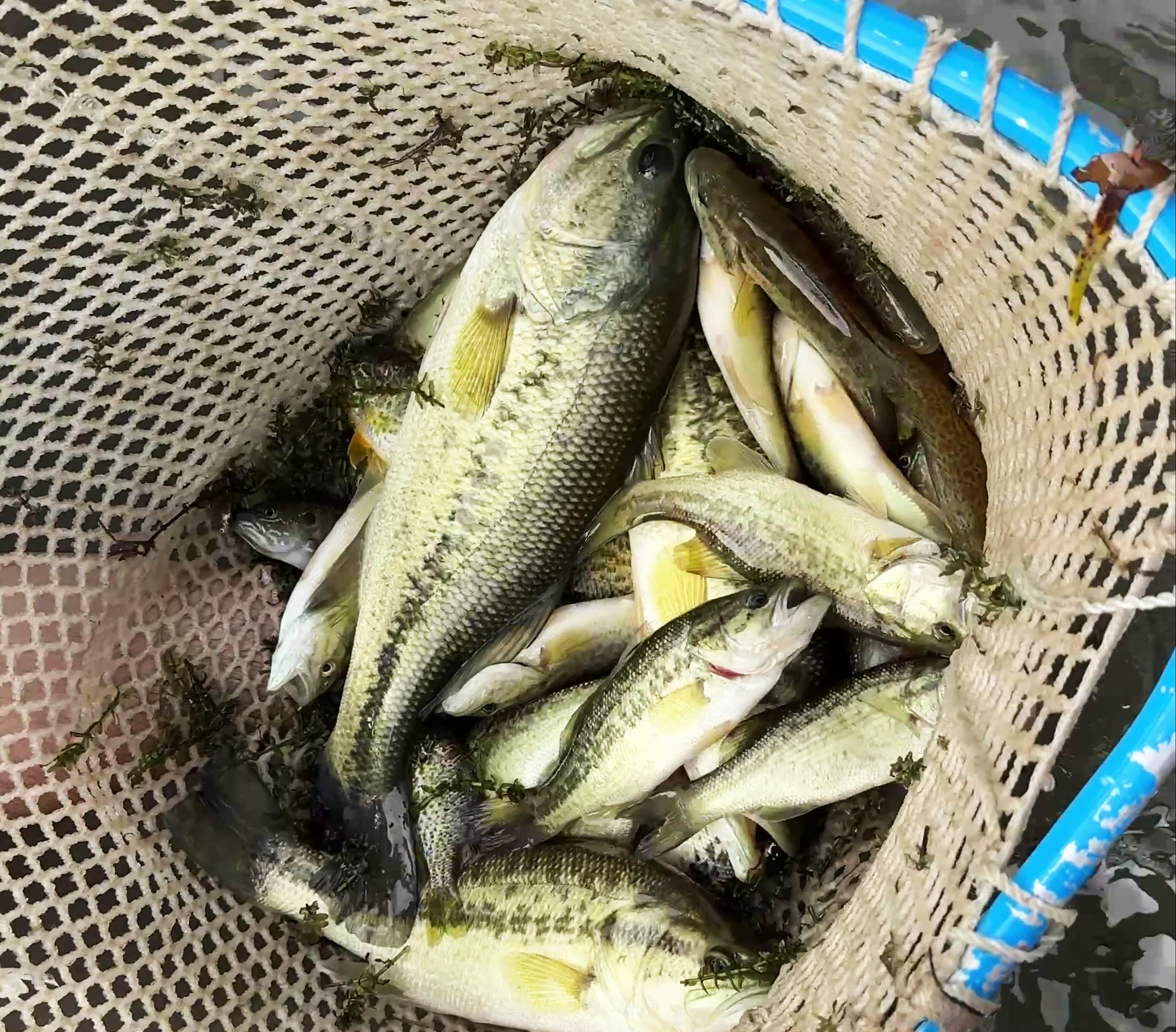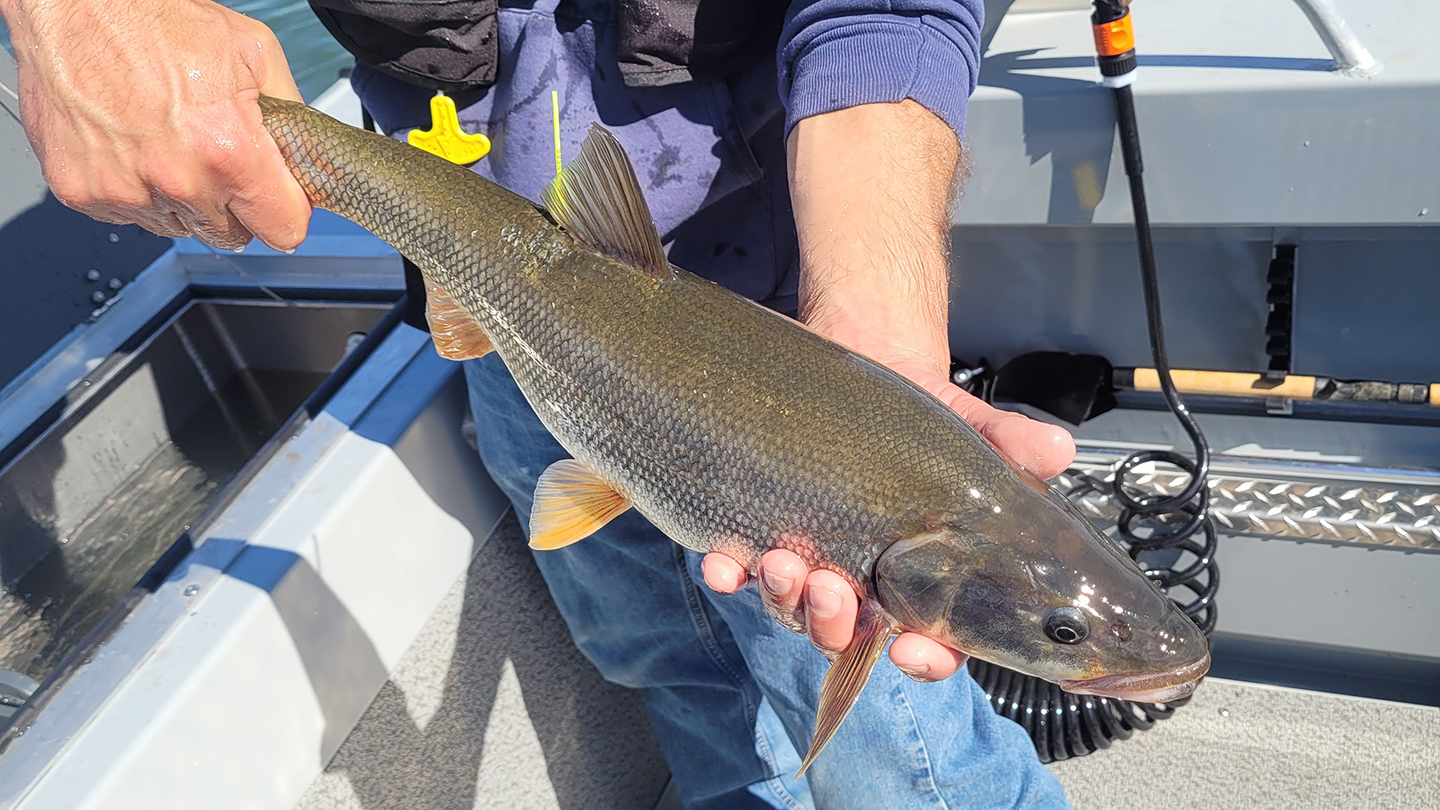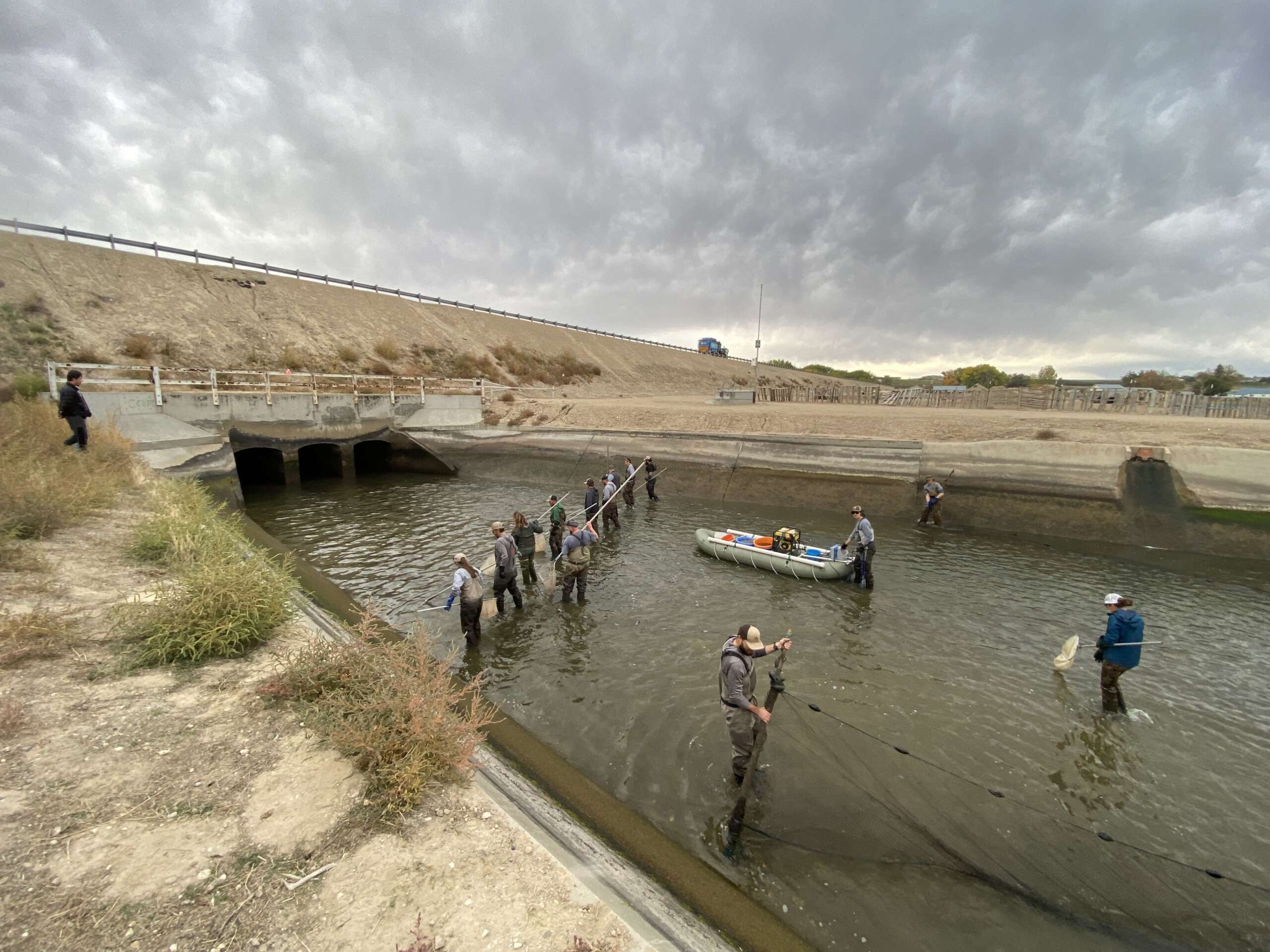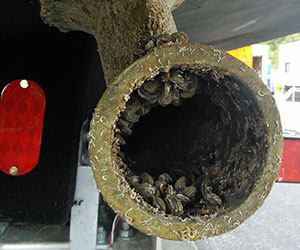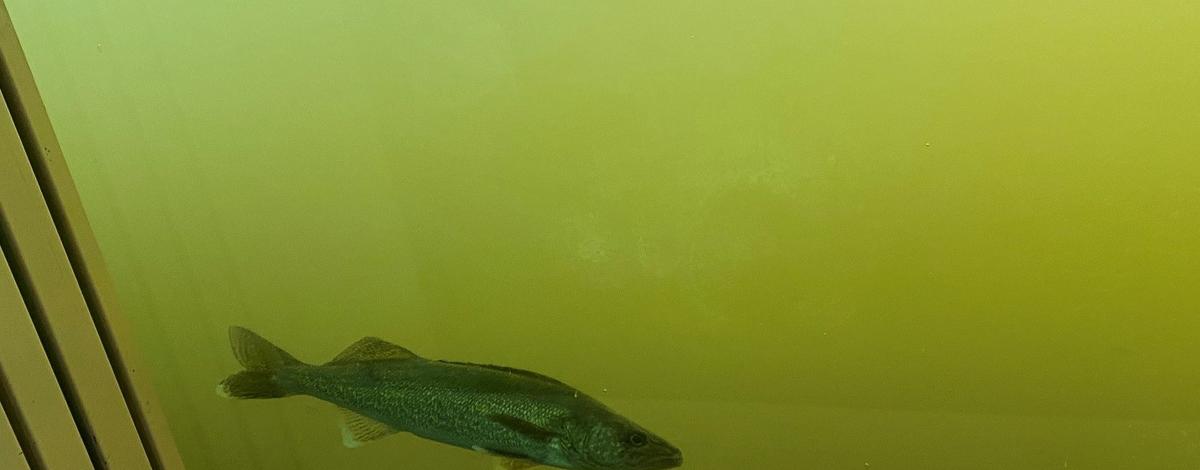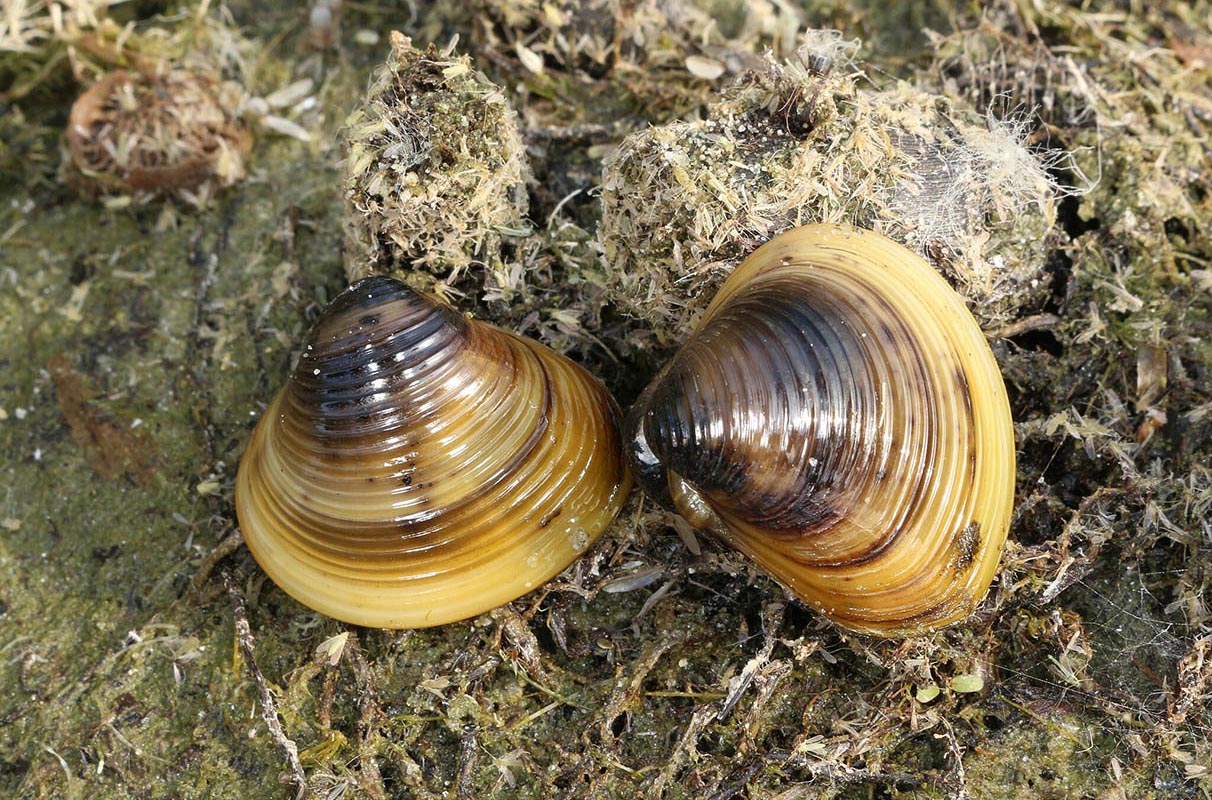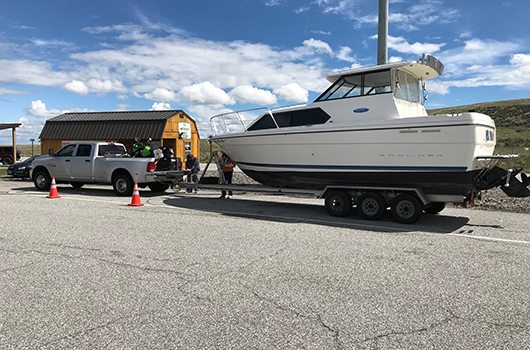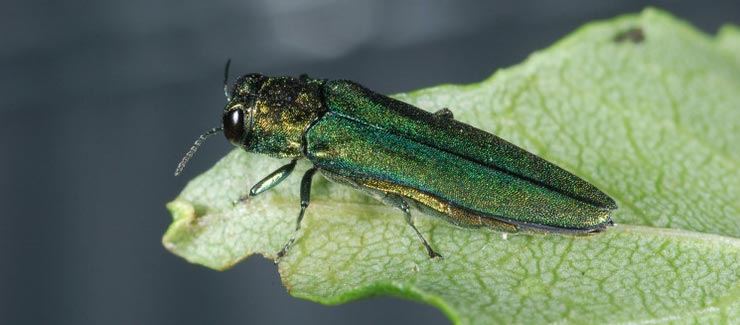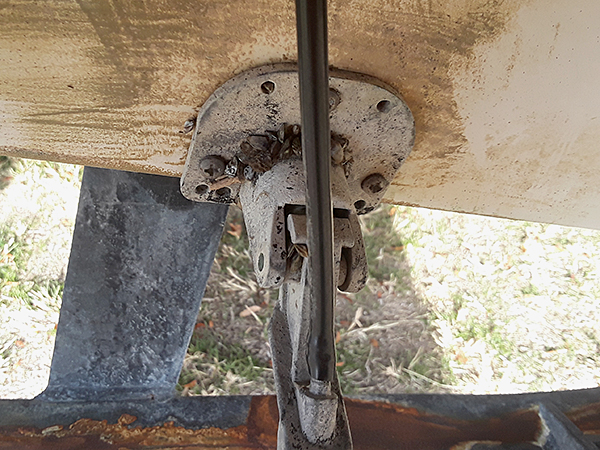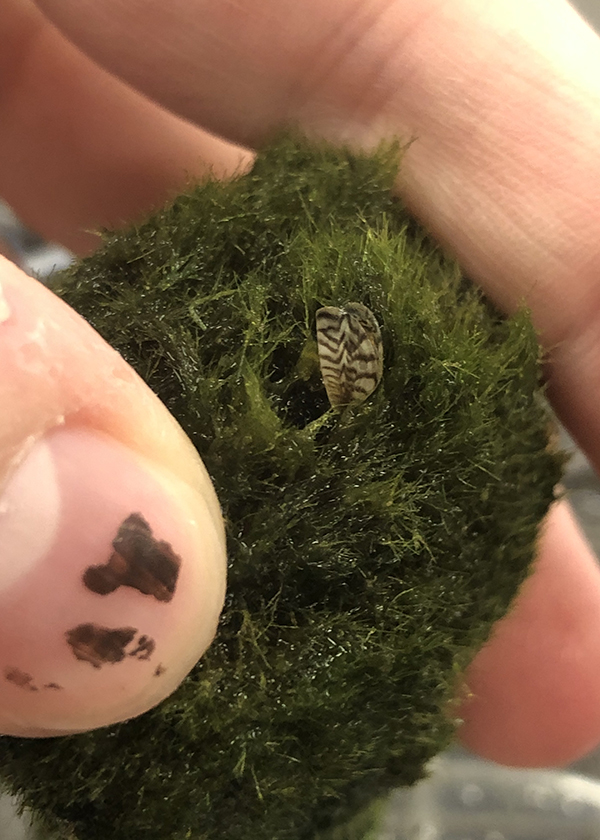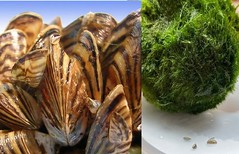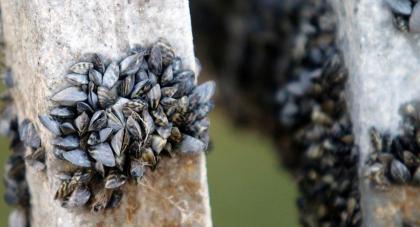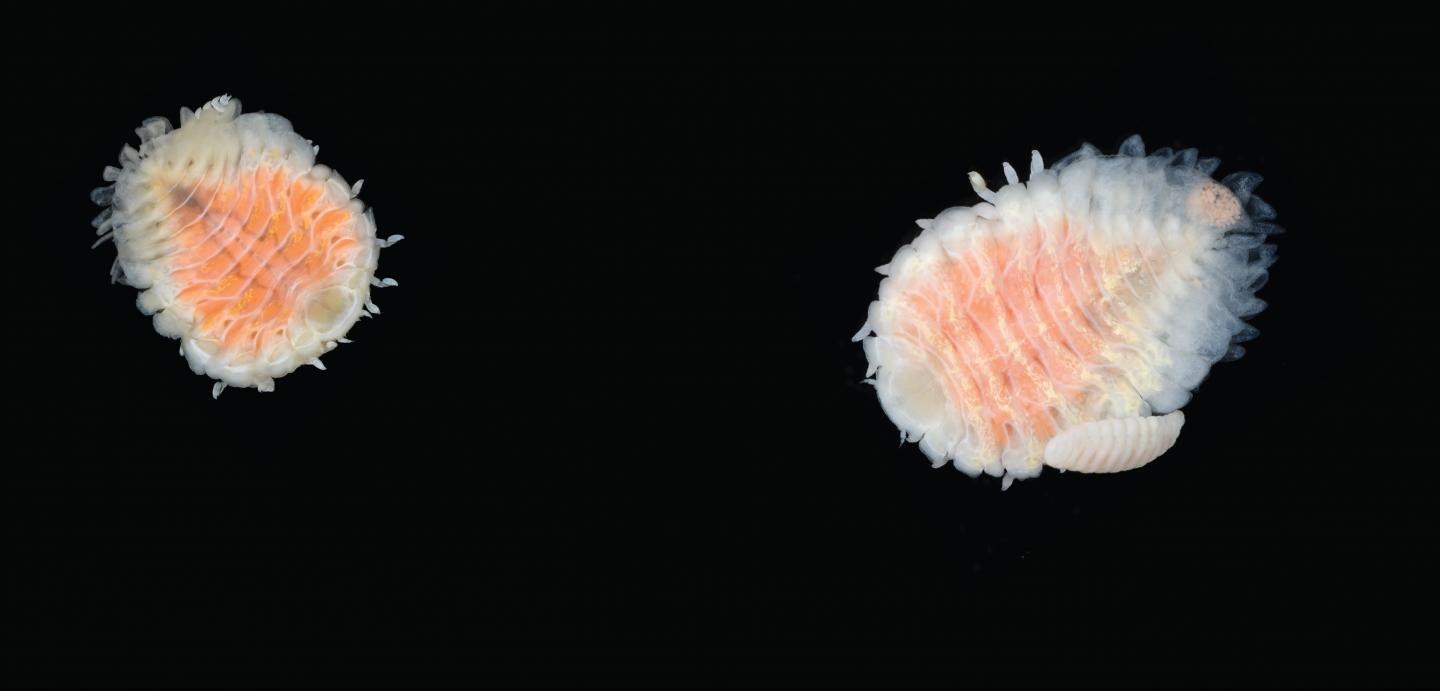Study Details Extensive Impacts Of Chemical Treatment Used To Eliminate Destructive Quagga Mussels In Snake River
August 29th, 2025
A copper-based chemical treatment to rid a portion of the Snake River of invasive quagga mussels – the first to be found in any Columbia Basin stream – destroyed up to 90 percent of water-based macroinvertebrates (bugs), nearly all gastropods (snails and slugs) and most white sturgeon residing near the area where the poison was applied, according to a recent study.
European Green Crab 2025 Field Season Update: WDFW, Tribes, Co-Managers Set 30,000 Traps This Year, Remove 300,000 Crabs
August 19th, 2025
European green crabs were first discovered in Washington state in 1998 in Willapa Bay, where they remained in small numbers for over a decade. The green crabs were first documented in Washington’s inland waters in the San Juan Islands in 2016.
‘The Risk Is Quite Staggering’: Invasive Mussel Threat Spurs States To Create Near-Term Action Plan
June 14th, 2025
Washington and Oregon are expanding efforts to prevent invasive mussels from entering the two states and the Columbia River basin. If they get a foothold in the basin, invasive zebra, quagga and golden mussels would cause considerable economic and environmental damage that could slow recovery of the basin’s federally listed salmon and steelhead runs, according to each state’s invasive species manager speaking at the May Northwest Power and Conservation Council meeting.
Washington State’s Green Crab Invasion: WSU Study Finds Juvenile Green Crabs Do As Much Damage As Adults
May 23rd, 2025
Scientists at Washington State University have found that juvenile European green crabs can do as much damage as adults to shellfish and native sea plants, calling into question current methods to eradicate the invasive crustaceans.
Washington Intercepts Tugboat At Watercraft Inspection Station Carrying 21 Gallons Of Invasive Mussels, Largest Volume From One Boat In 7 Years
February 7th, 2025
Two tugboats infested with quagga and zebra mussels were intercepted last month at the Spokane watercraft inspection station.
Voracious Juvenile Sablefish Spreading Into Warming Northwest Coastal Waters Compete With Young Salmon For Prey
January 20th, 2025
There is a new mouth to feed in the coastal waters of the Northwest where juvenile salmon first enter the ocean, and it’s a hungry one.
Walleye Abundance Increasing At Alarming Rate In Snake, Salmon Rivers, Idaho Seeks Angler Help To Slow The Spread
November 1st, 2024
Walleye are spreading at an alarming rate upstream in the Snake and Salmon rivers and now occupy critical rearing and migratory areas of juvenile salmon and steelhead, says Idaho Fish and Game.
More Invasive Quagga Mussels Found Again In Snake River, Idaho To Respond With Chemical Treatment Plan
September 27th, 2024
The Idaho State Department of Agriculture announced this week the detection of a small number of quagga mussels in the Twin Falls area of the Snake River.
Last Year’s Snake River Invasive Mussel Incident Has F&W Managers On High Alert; Widespread Infestation Poses Billions In Damage
August 18th, 2024
The state of Idaho has shifted from an aggressive rapid response – the emergency eradication of quagga mussels found in the mid-Snake River near Twin Falls last year -- to prevention and containment, according to Nic Zurfluh, Invasive Species Bureau Chief at the Idaho State Department of Agriculture. The incident was the first time invasive, destructive mussels were verified in the Columbia River basin.
Once Again Invasive Zebra Mussels Found In Aquarium Moss Balls In Washington, Prompts Rapid Response
August 18th, 2024
The Washington Department of Fish and Wildlife received notification last week from a local wholesale aquarium company in Renton of possible invasive freshwater mussels on a shipment of Marimo moss balls. Moss balls are a commonly used decorative algae in aquariums and water gardens.
USFWS Releases Strategy To Avoid Extinction Of Northwest Spotted Owls: Lethally Remove Small Numbers Of Invasive Barred Owls
July 4th, 2024
The U.S. Fish and Wildlife Service this week released its final environmental impact statement analyzing proposed barred owl management alternatives to protect northern and California spotted owls in Washington, Oregon and California from invasive barred owls.
Bass Predation Primary Reason For Struggling Wild Chinook In Oregon River, ODFW Allowing Spearfishing To Remove The Invasive Fish
July 4th, 2024
Spearfishing for bass is allowed on southwest Oregon’s Coquille River through Oct. 31. Spears, spear guns and angling with bait to take smallmouth bass is allowed, and there are no harvest size or limits.
For First Time Invasive, Predatory Pike Show Up In Montana Clark Fork River Tributary, Posing Threat To ESA-Listed Bull Trout
June 21st, 2024
Montana Fish, Wildlife & Parks is asking anglers to report any northern pike caught or observed in the Bull River, a tributary of the Clark Fork River, following the first confirmed detection of the predacious non-native fish. The Clark Fork River in northwest Montana flows into Lake Pend Oreille in northern Idaho.
Invasive Walleye Moving Higher Into Snake River Basin, Threatening Wild, Hatchery Stocks Of Juvenile Salmon, Steelhead, Lamprey
March 22nd, 2024
Walleye, an invasive species with a reputation for a voracious appetite, has moved down the Columbia River from Lake Roosevelt and are now being counted in increasing numbers upstream of Lower Granite Dam on the Snake River, according to a report by the Idaho Department of Fish and Game.
Efforts To Suppress Salmon-Eating Northern Pike In Upper Columbia Successful, But Require Long-Term, Sustained Effort
February 16th, 2024
Efforts to suppress northern pike in reservoirs upstream of Chief Joseph and Grand Coulee dams so far have been successful at keeping the voracious predator from populating waters downstream in what is considered the “anadromous zone” where it is feared the invasive fish would decimate salmon and steelhead runs in the Columbia River basin. Many of those anadromous fish are listed under the federal Endangered Species Act.
IDFG Surveys Impact On Fish From Copper Treatment Used To Kill Quagga Mussels In Snake River; Tons Of Dead Fish, While Some Species Survived
December 13th, 2023
Idaho Fish and Game biologists quickly learned that the copper treatment to rid a stretch of the Snake River from quagga mussels caused high mortality in certain species – at least six to seven tons of dead fish -- while others survived quite well.
Idaho Details Successful Eradication Treatment Of Invasive, Destructive Quagga Mussels In Snake River, First Sighting In Columbia River Basin
November 16th, 2023
Idaho completed a 10-day treatment to rid a sixteen-mile section of the mid-Snake River near Twin Falls of quagga mussel larvae (veligers) and at least two adult mussels. The state says the treatment was largely successful, although it and other partners will continue to test for at least the next five years.
Scientists Review Pikeminnow Removal Rewards Program; Decrease In Abundance Concurrent With Bass, Walleye Increase?
October 26th, 2023
Studies over the 33-year history of a program designed to remove Northern Pikeminnow, a natural predator of salmon and steelhead smolts, from the Columbia and Snake rivers still has not been able to make a direct connectionbetween mass removals of the predator and recovery of salmonids in the rivers, according to a recent report by the Independent Scientific Review Panel.
IDFG Says Invasive Walleye Established In Lake Lowell Near Nampa, Concerns About Spread Into Snake River
October 26th, 2023
Idaho Fish and Game biologists learned on Oct. 10 that Lake Lowell near Nampa now likely has a reproducing population of walleye. While the effects to Lake Lowell and other area fisheries are uncertain at this point, they are concerned about what this might mean for this fishery and others in Southwest Idaho, including the Snake River below Hells Canyon, which is a major migration corridor for salmon and steelhead.
Researchers Show E-DNA Detects Genetic Diversity Of Invasive Fish; Can Help Trace Source Of New Population, Prevent Further Invasions
September 28th, 2023
Ecologists have demonstrated that the genetic material that species shed into their environments can reveal not only the presence of the species but also a broad range of information about the genetics of whole populations — information that can help scientists trace the source of a new invasive population as well as prevent further invasion.
Idaho Initiates Rapid Response Plan After Quagga Mussel Larvae Detected In Snake River Near Twin Falls; WDFW Increases Monitoring
September 22nd, 2023
The Idaho State Department of Agriculture confirmed this week the presence of quagga mussel larvae in the Snake River at Twin Falls. Multiple samples of quagga mussel at larval life stages have been found in the Centennial Waterfront Park area by ISDA’s early detection monitoring program.
Bad News For Salmon: Walleye Spreading Into Idaho, Most Reports Ever Of Walleye Upstream Of Lower Granite Dam
August 23rd, 2023
Idaho Fish and Game has received more verified reports and pictures from people catching walleye in the Hells Canyon reach of the Snake River and Salmon River in 2023 than in all previous years.
WSU Study Shows Substantial Spread Of Invasive Asian Clams In Columbia River, Threat To River’s Food Web
July 13th, 2023
The invasive Asian clam is more common in the lower Columbia River than its native habitat of southeast Asia, according to a study of the clam’s abundance in the river.
Columbia River Basin Still Only Major Basin In U.S. Free Of Destructive Zebra/Quagga Mussels; Fluctuating Reservoirs May Provide Some Protection
February 17th, 2023
The Columbia River basin in 2023 is still the only major river basin in the U.S. free of quagga and zebra mussels, largely due to the Northwest’s four-state watercraft inspection efforts, according to a presentation this week at the Northwest Power and Conservation Council by Stephen Phillips, senior program manager at the Pacific States Marine Fisheries Commission.
Emerald Ash Borer Found In Oregon (First On West Coast); Potential To Destroy Large Numbers Of Trees Key To Salmon Habitat
October 6th, 2022
A small invasive beetle that has decimated ash groves in the Midwest was found in Oregon earlier this summer, the first to be found on the West Coast. When – not if – it spreads in Oregon, it has the potential to destroy large swaths of ash trees in forests and along streams located on the west side of the Cascade Mountains. The loss of the trees could impact salmon and steelhead in the Willamette Valley.
Washington Implements Incident Command System To Battle Habitat-Destroying Invasive Green Crabs: 64,000 Removed This Year
June 23rd, 2022
Deployment of emergency measures to control invasive European green crabs on the Washington Coast and at sites within the Salish Sea is well underway, including the implementation of an Incident Command System to facilitate statewide coordination between various agencies, tribes, and partners.
Report Details States’ Efforts In 2021 To Block Invasive Mussels From Gaining Foothold In Northwest; 162 Fouled Boats Stopped
May 6th, 2022
In the battle to block destructive zebra and quagga mussels from infesting Pacific Northwest waters, the four states at watercraft inspection stations in 2021 intercepted 55 more fouled boats than last year even though the number of total inspections were substantially less than in 2020.
Suppression Of Northern Pike In Lake Roosevelt Showing Much Success; Goal Is To Reduce Population To ‘Almost Undetectable Levels’
February 17th, 2022
An effort by tribes, the state of Washington and federal agencies to suppress or eradicate invasive Northern Pike is bearing fruit in Lake Roosevelt, the reservoir behind Grand Coulee Dam, according to an update by biologists at this week’s meeting of the Northwest Power and Conservation Council’s Fish and Wildlife Committee.
European Green Crab Invasion In Washington Worsens: Researchers Using E-DNA To Contain, Prevent New Outbreaks
February 17th, 2022
European green crabs feast on shellfish, destroy marsh habitats by burrowing in the mud and obliterate valuable seagrass beds. The invasive species also reproduces quickly, making it a nightmare for wildlife managers seeking to control its spread in Washington’s marine waters.
Montana Study Reveals How Invasive Species Over Time Disrupt Native Species’ Food Webs; Lake Trout Vs. Bull Trout
November 11th, 2021
Invasive species cause biodiversity loss and about $120 billion in annual damages in the U.S. alone. Despite plentiful evidence that invasive species can change food webs, how invaders disrupt food webs and native species over time has remained unclear.
Future Bright For American Shad, Most Abundant Anadromous Fish In Columbia River Basin; Risks To Native Salmonids Unknown
October 28th, 2021
American shad, a non-native fish species introduced to the Columbia River basin in the late 1800s, has replaced salmon and steelhead as the most abundant anadromous fish in the basin – by a long shot – and, although there are a number of uncertainties, their abundance could be impacting salmon and steelhead recovery in the Columbia and Snake rivers, a recent report says.
Montana Has Already Stopped More Mussel-Fouled Boats This Year Than All Of 2020
July 8th, 2021
On Sunday, June 27, watercraft inspection stations in eastern Montana intercepted two boats entering the state carrying invasive mussels, making it the 35th and 36th mussel-fouled boats intercepted this year. This surpasses the total number of 35 mussel-fouled boats intercepted in 2020.
Find Invasive Species In Early Stages: E-DNA Being Used To Successfully Detect Unknown Incursions
June 3rd, 2021
Biologists led by the University of Iowa discovered the presence of the invasive New Zealand mud snail by detecting their DNA in waters they were inhabiting incognito. The researchers employed a technique called environmental DNA to reveal the snails' existence, showing the method can be used to detect and control new, unknown incursions by the snail and other invasive species.
Report Shows Northwest Watercraft Inspections In 2020 Intercepted 107 Mussel-Fouled Boats, Up From 2019
April 30th, 2021
A draft report by the Pacific States Marine Fisheries Commission shows that funding for watercraft inspection stations in the four Northwest states in 2020 remained nearly the same as levels spent in 2019. However, interceptions of small watercraft infested with zebra or quagga mussels at the states’ borders rose by 15 percent.
Oregon Issues Emergency Rules Prohibiting Import Of Aquarium Moss Balls That Might Carry Zebra Mussels; Washington ‘Don’t Let It Loose’ Art Contest
April 22nd, 2021
The Oregon Department of Agriculture has filed emergency rules prohibiting the import of Marimo or moss balls infested with invasive zebra mussels.
Managing Lake Pend Oreille Fisheries: 240,000 Non-Native Lake Trout Removed Since 2006, Walleye Now Targeted
April 9th, 2021
On the heels of a successful and significant reduction of lake trout in Lake Pend Oreille, Idaho is now using some of the same methods – gillnetting and an angler rewards program – it used to fight lake trout in a new effort to reduce the population of invasive walleye in the lake.
B.C. Conservation Officers Seize Nearly 3,000 Moss Balls Suspected Or Confirmed To Carry Invasive Zebra Mussels
April 9th, 2021
Nearly 3,000 moss balls, which are suspected or confirmed to be contaminated with zebra mussels, have been seized or surrendered to British Columbia conservation officers as part of widespread efforts to stop the potential spread of the invasive species.
Precautionary Tale On Eradicating Invasive Species: ‘Don’t Try To Get Them All, Or Could Come Back To Bite You’
March 18th, 2021
Some invasive species targeted for total eradication bounce back with a vengeance, especially in aquatic systems, finds a study led by the University of California, Davis.
Invasive Zebra Mussels Found In Pet Stores In 21 States, Including Northwest: ‘This Was Not A Pathway We’d Been Aware Of Until Now’
March 11th, 2021
A citizen’s report of an invasive zebra mussel found in an aquarium moss package found in a pet store prompted a U.S. Geological Survey expert on invasive aquatic species to trigger nationwide alerts last week that have led to the discovery of the destructive shellfish in pet stores in at least 21 states from Alaska and the Northwest to Florida.
‘Functional Eradiction’: Canadian Study Says Limiting Invasive Species May Be Better (Achievable) Goal Than Elimination
March 5th, 2021
Managing invasive species--not eliminating them altogether--is a better use of time and conservation resources in many cases, according to a study led by a University of Alberta biologist.
Washington Aquatic Invasive Species Unit Finds, Decontaminates Record Number Of Mussel-Infested Boats In 2020; Feds Sign MOA To Boost Coordination
December 3rd, 2020
The Washington Department of Fish and Wildlife’s Aquatic invasive species unit in 2020 detected more boats than ever fouled with non-native organisms.
After B.C. Discovery Scientists Monitoring Alaskan Waters For Invasive, Voracious European Green Crab; Threat To Salmon, Dungeness Crab
December 3rd, 2020
Natural resource managers in British Columbia discovered several adult male and female European green crabs on Haida Gwaii this past July. Alarm bells immediately went off for biologists in Alaska.
Interior Issues Report Detailing Actions ‘Safeguarding The West’ From Invasive Mussels With Focus On Columbia River Basin
November 20th, 2020
The U.S. Interior Department last week released a report on the “Safeguarding the West from Invasive Species initiative,” an effort aimed at enhancing actions by federal, state and tribal governments to prevent the spread of invasive zebra and quagga mussels to uninfested Western waters, such as those in the Columbia River Basin.
UW Study Uses Mobile Technology Tracking Movement Of Anglers To Predict Where Invasive Species May Be Spreading
October 1st, 2020
Unknowingly, anglers may be transporting small aquatic "hitchhikers" that attach themselves to boats, motors -- and even fishing gear -- when moving between bodies of water.
Marine ‘Bioblitz’ Finds Invasive Shrimp-Sucking Parasite Continuing Northward Pacific Expansion Into B.C.; ‘A Bit Depressing’
September 24th, 2020
Researchers have identified an invasive blood-sucking parasite on mud shrimp in the waters of British Columbia's Calvert Island. The discovery represents the northern-most record of the parasite on the West Coast and is likely an indication of its ability to spread without human transport.
Invasive New Zealand Mud Snails Found At Montana Hatchery; Have Been Detected Over The Years In Columbia/Snake Basin
August 27th, 2020
The discovery of New Zealand mudsnails has shut down the state of Montana’s third largest hatchery, a trout production facility near Bridger. The discovery was at a hatchery located in the Missouri River drainage of Montana.
Stopping Invasive Mussels: Watercraft Inspections Rise Across Four States; Quagga/Zebra Mussel Interceptions Drop Slightly
March 26th, 2020
The number of watercraft inspections completed in 2019 across the four Northwest states rose 6 percent from 2018, but the number of contaminated recreational vessels intercepted at the stations that had invasive quagga or zebra mussels attached dropped 2 percent to 93 boats, according to a draft report by the Pacific States Marine Fisheries Commission that was completed last week.
New Western Invasive Species Council Formed; Members Appointed From 16 States
January 2nd, 2020
The Western Governors Association has launched the Western Invasive Species Council to enhance coordination between existing state invasive species councils, improve communication and collaboration on regional biosecurity and invasive species control efforts, and to advocate for regional needs at the federal level. Governors appointed 16 members to the new council.
Efforts On Early Detection Monitoring Of Invasive Species – Mussels, Pike — In Washington State Detailed; Environmental DNA Major Tool
October 17th, 2019
Two different anglers on two different waterbodies, but both in the anadromous zone of the Columbia River basin and both on the same day – July 17, 2017 – say they saw one of the most feared invasive predators in the basin, a northern pike. But, their alleged sightings were quickly debunked … by science.
Aquatic Invasive Species Inspection Stations Closing As Season Ends; 259,000 Watercraft Checked, 87 Mussel Interceptions
October 3rd, 2019
As inspection stations that search arriving watercraft for aquatic invasive species – especially quagga and zebra mussels – begin to close, the State of Montana reported that it had completed 110,000 watercraft inspections in 2019.
PUDs, Tribes Asking For Help From Anglers In Reducing Northern Pike Numbers Above Grand Coulee; $10 For Every Pike Head
August 29th, 2019
The Grant, Chelan and Douglas Public Utility Districts are contributing to an effort by tribes and state agencies to control Northern Pike, a voracious predator that, if not contained, could set back decades of salmon recovery efforts across the Pacific Northwest.
Council, Representing NW States, Expresses Support For Corps’ Cost-Sharing, Rapid Response Plan If Invasive Mussels Invade Basin
August 14th, 2019
A letter in support of a U.S. Army Corps of Engineers’ rapid response plan for invasive mussels got a thumbs up from the Northwest Power and Conservation Council.
Corps Prepares Plans To Execute Rapid Response Measures If Mussels Discovered In Columbia River Basin, Northwest Water Bodies
July 24th, 2019
An invasion of quagga and zebra mussels is being held off at the borders of Northwest states through the efforts of invasive species inspection stations, but the U.S. Army Corps of Engineers’ Walla Walla District is preparing for the worst.
Montana Details Its High-Level Effort To Keep Zebra, Quagga Mussels Out Of Basin; Funding For More Inspection Stations Would Help
July 18th, 2019
In a state that lies in the upper headwaters of the Columbia River basin and considers itself guardians in keeping zebra and quagga mussels out of the basin, Montana says that more can be done and calls on the Bonneville Power Administration to help fund permanent watercraft inspection stations.
Study: As Regional Climate Warms, Smallmouth Bass Will Encroach On Much More Salmonid Spawning, Rearing Habitat
July 11th, 2019
Nearly 18,000 river kilometers (11,185 miles) of Columbia River basin streams currently has suitable habitat for an invasive predatory fish that, as climate warms, is a range that is predicted to increase by 10,000 river miles by 2080, according to a recent study.
New Water Quality Permits For Atlantic Salmon Farms Include Stronger Protections For Puget Sound; No Non-Native Fish Farms By 2022
July 10th, 2019
Beginning in 2022, fish farms will no longer be allowed to raise non-native fish in Washington’s waters. Until then, updated permits from the Washington Department of Ecology require Atlantic salmon farms to step up their monitoring, inspections and reporting, and to have emergency response plans, the agency said Thursday.
Western Governors Call For Western Invasive Species Council; More Federal Cooperation, Funding
June 18th, 2019
The Western Governors Association at its annual meeting last week approved a resolution calling for the creation of a new Western Invasive Species Council; new mechanisms to enhance regional invasive species research, planning and coordination; and recommendations to Congress and federal agencies on improving invasive species management on federal lands and supporting state-led management efforts.
Quantifying Economic Costs Of Northern Pike Invasion; ‘Would Require Large-Scale Ecological-Economic Exercise’
June 13th, 2019
Economists tasked with quantifying the costs of suppressing invasive northern pike in Lake Roosevelt as well as the costs to the region if the pike escaped Grand Coulee Dam and migrated downstream, risking recovery of the Columbia River basin’s threatened and endangered salmon and steelhead, indicated at a Northwest Power and Conservation Council meeting this week that available data is too sparse to adequately answer the questions.
Western Governors’ ‘BioSecurity’ Report Recommends Ramping Up Actions To Stop Destructive Invasive Mussels From Contaminating Columbia Basin Waters
June 11th, 2019
If invasive quagga and zebra mussels spread to the Columbia River Basin — the last major un-infested water system in the continental U.S. — the control costs in the basin alone could reach $500 million annually, says the Biosecurity and Invasive Species report released this week by the Western Governors’ Association.
Stopping Invasive Mussels: Congress, Administration Urged To Empower State-Led Programs Rather Than Create New Response System
May 30th, 2019
The Western Governors Association is urging Congress and the Trump Administration to “support and empower state-led rapid response programs” to manage the risks of aquatic invasive species, including zebra and quagga mussels, rather than creating a new response system.
Draft Report: Watercraft Inspections For Invasive Mussels Increased By 23 Percent Last Year
March 26th, 2019
The four Northwest states completed 23 percent more watercraft inspections in 2018 than in 2017, intercepting 16 percent more contaminated recreational vessels that had quagga or zebra mussels attached than in the previous year, according to a draft report by the Pacific States Marine Fisheries Commission that was completed last week.
IDFG To Host Lake Pend Oreille State Of The Lake Meeting; Updates On Fish Stocks’ Status
March 26th, 2019
Idaho Fish and Game staff will share updates on the Lake Pend Oreille fishery and activities planned for 2019 at the annual State of the Lake public meeting on Thursday, April 4 from 6-8 p.m. at the Pend Oreille Events Center. The Events Center is located at 401 Bonner Mall Way, Suite E, in Pend Oreille.
Research: Rising Global Shipping Traffic Could Lead To Surge In Invasive Species Over Next 30 Years
March 26th, 2019
Rising global maritime traffic could lead to sharp increases in invasive species around the world over the next 30 years, according to a new study by McGill University researchers.
Registration Open For Columbia Basin Transboundary Conference In British Columbia
March 15th, 2019
Online registration is open for the Columbia Basin Transboundary Conference: One River, One Future, an international conference addressing key issues related to the future of the Columbia River, its ecosystem, management, and international implications.
Montana Opens First Watercraft Inspection Stations To Prevent Spread Of Invasive Species
March 15th, 2019
The first watercraft inspection stations of 2019 will opened this month in Kalispell, Ravalli and Browning. Watercraft inspection stations are Montana’s first line of defense to prevent the movement of aquatic invasive species.
Washington’s 2018 State Of Salmon Report: Six Columbia/Snake ESA Listed Stocks Not Making Progress
February 1st, 2019
Nearly $1 billion has been spent on salmon recovery activities in the State of Washington since 1999 when the Washington legislature passed the state’s Salmon Recovery Act, according to an annual report released this month by Gov. Jay Inslee’s Salmon Recovery Office.
Montana Reviews End Of Year Statistics For Aquatic Invasive Species Program
January 11th, 2019
The state of Montana last year inspected a record numbers of watercraft and took a record number of water samples testing for aquatic invasive species in the state, finding no mussel larvae or adult mussels while sampling the water, according to information from Montana Fish Wildlife and Parks, which operates the state’s aquatic invasive species program.
Upper Columbia Basin Bull Trout Study Finds Small Populations Declining, At Risk
December 21st, 2018
Bull trout populations in the upper Columbia River basin in Idaho and Montana are small and some are continuing to decline, according to a recent study.
Leading Practitioners Of eDNA Science Gather To Discuss New Tool’s Possibilities
November 30th, 2018
An innovative tool that can confirm the recent presence of any given fish species in a sample of water will be highlighted at the first National Conference on Marine Environmental DNA held in New York City. The conference began Thursday and continues today, Nov. 30.
Researchers Identify Invasive Algae From Japanese Tsunami Debris On PNW Coast; None Gain Foothold
October 26th, 2018
Researchers from the United States and Japan have identified 84 species of marine algae and cyanobacteria that arrived on the Pacific Northwest coast via debris from the 2011 Tohoku earthquake and tsunami and, to date, none have gained a foothold in U.S. coastal waters.
Where Did Pike In Columbia Basin Come From? Detection, Suppression Necessary To Slow Invasion
October 12th, 2018
Northern pike is a fish that is broadly distributed across the northern hemisphere, but is not native to the Pacific Northwest, and it remains unwanted.
Its presence as low in the Columbia River basin as Lake Roosevelt is now posing a threat to native fish downstream of Grand Coulee Dam in what many are calling the anadromous zone where salmon and steelhead fish spawn, rear and eventually migrate to and from the ocean.
Orca Task Force Recommendations Include Focus On Salmon Runs; Non-Native Game Fish To ‘Predatory’
September 28th, 2018
An international task force brought together by Washington Gov. Jay Inslee in March this year released a list of proposed recommendations this week that, if implemented, they hope will revive the endangered population of Southern Resident Orca whales in northern Washington and British Columbia.
Scientific Tool Uses Otolith Geochemistry To Identify Source Of Illegally Introduced Invasive Fish
September 28th, 2018
An innovative scientific tool was used in Montana to identify when an invasive fish was introduced to a water body and where that fish came from.
Corps Seeks Comments For Next Stage Of Draft Mid-Columbia Master Plan
September 28th, 2018
A draft land and resource use management plan for three mid-Columbia River dams, as well as Willow Creek Dam near Heppner, Oregon, is out for review and comment.
NOAA Fisheries Releases Final Recovery Plan For Southern Population Of Green Sturgeon
August 30th, 2018
NOAA Fisheries has released a final recovery plan under the Endangered Species Act for Central California’s green sturgeon.
Report Summarizes Tribes’ Work, Results From 10 Years Of Columbia River Fish Accords
August 17th, 2018
A program that has consumed an average of 18 percent of the Bonneville Power Administration’s fish and wildlife budget each year and has cost the agency over $560 million over its 10-year life is coming to end, although it may be extended.
Fighting The Northern Pike Invasion Into Basin: Spokane Forum Calls Economic Impact Study A Priority
July 27th, 2018
A movement is underway to pursue a comprehensive study of the potential economic impacts that could come with an advancing northern pike invasion across the Columbia Basin river system, including salmon waters referred to as “The Anadromous Zone.”
Halfway Through Boating Season, Montana Has Intercepted 12 Boats With Invasive Mussels
July 27th, 2018
With summer half over, more than 50,000 watercraft have been inspected at Montana Fish, Wildlife and Parks aquatic invasive species inspection stations around the state.
Council Briefed On Status, Funding Of Efforts To Halt Invasive Mussels With Watercraft Inspections
July 13th, 2018
The frontline defense against the entry of invasive and damaging quagga and zebra mussels into the Northwest is Montana’s huge program to detect infested boats as they enter the state. It is also the only one of four Northwest states that has detected mussels in water bodies -- Tiber and Canyon Ferry reservoirs east of Continental Divide.
Council OKs $4.5 Million For 5-Year Program To Suppress, Monitor Invasive Pike In Lake Roosevelt
June 15th, 2018
A proposal to beef up suppression and monitoring of invasive northern pike in Lake Roosevelt was approved this week by the Northwest Power and Conservation Council.
Washington Stops Boat With Invasive Mussels East Of Spokane; Was Traveling Michigan To Alaska
June 8th, 2018
The Washington Department of Fish and Wildlife last week found invasive, non-native zebra mussels on a boat stopped for inspection at the Washington-Idaho border on Interstate 90 just east of Spokane.
Montana Intercepts Another Boat Carrying Zebra Mussels; Headed From Wisconsin To Alberta
June 1st, 2018
The Montana Fish, Wildlife and Parks Wibaux watercraft inspection station intercepted a boat carrying zebra mussels last week. The owner purchased the used boat and was transporting it to Alberta, Canada. The last launch of the boat was in Sturgeon Bay in Wisconsin.
Study Suggests Managers Should Reduce Fishing Pressure On Large Fish To Maintain Stocks
May 18th, 2018
What difference does it make whether an angler catches one big fish or two smaller fish, each half its weight?
Scientists Express Skepticism About Stopping Lake Roosevelt Northern Pike From Spreading Downstream
April 27th, 2018
In its most recent review of the Lake Roosevelt Northern Pike suppression program, the Independent Scientific Review Panel said the project meets scientific review criteria with qualifications, but it also said it has doubts that efforts to suppress northern pike in the Columbia River basin could ever be fully successful, especially given current efforts.
Northwest Boat Inspection Stations Opening For Invasive Species Check; Both Motorized, Non-Motorized
April 20th, 2018
Boating season is starting and people hauling both motorized and non-motorized boats must stop at watercraft inspection stations opening around Oregon next week.
Study: Extirpation Chances Remain High For ESA-Listed Bull Trout In Upper Columbia River Basin
April 6th, 2018
Most migratory bull trout populations in the Upper Columbia River are found in low abundance and their numbers are either stable or declining, according to a recent study.
Interior Department Releases Report On Fight Against Invasive Mussels
March 16th, 2018
The U.S. Department of the Interior has released a report highlighting the progress made in the fight against invasive zebra and quagga mussels, which can impair the delivery of water and power, diminish boating and fishing, and devastate ecosystem health.
Corps Seeks Comments On Estuary Habitat Project Using Dredge Spoils
March 16th, 2018
A proposed project in the lower Columbia River estuary spearheaded by the U.S. Army Corps of Engineers intends to use dredge spoils from the river’s shipping channel to restore habitat on the Washington shore near the town of St. Helens, Oregon.
Scientists Want More Detailed Information On Northern Pike Suppression Plan In Lake Roosevelt
February 16th, 2018
A proposal to expand a program this spring designed to suppress non-native Northern Pike in Lake Roosevelt was sent back to the program sponsors for more information in January.
Corps Seeks Comments On Mid-Columbia River Regional Master Plan
February 2nd, 2018
A master plan that will guide the administration and development of federal lands surrounding Bonneville, The Dalles and John Day dams is out for review and comment.
Corps/States Effort To Prohibit Invasive Mussels Saw 49 Percent Increase In Boat Interceptions
January 26th, 2018
In the first year that northwest states and the federal government shared the costs to intercept zebra and quagga mussels at the borders, inspection stations saw a 42 percent increase in inspections and a 49 percent increase in interceptions.
Council Hears About Success Of South Fork Flathead Westslope Cutthroat Conservation Project
October 20th, 2017
A 10-year project to restore genetically pure native westslope cutthroat trout to northwest Montana’s South Fork of the Flathead River is coming to a successful close.
Council Approves Questions For Independent Science Board To Address In Review Of Basin Fish And Wild
October 13th, 2017
Following a formal, but general letter to the Independent Science Advisory Board requesting a review of its 2014 Columbia River Basin Fish and Wildlife Program, the Northwest Power and Conservation Council this week approved a less formal, but more detailed query to the ISAB for more information.
Montana To Close Invasive Mussels Inspection Stations For Season; Found 16 Contaminated Boats
October 13th, 2017
Montana Fish, Wildlife and Parks aquatic invasive species inspection stations will close for the season on Oct. 15. Boaters that are still in need of an inspection can receive one at a regional FWP office.
Study:Japanese Tsunami Enabled Hundreds Of Aquatic Species To Raft Across Pacific To U.S. West Coast
September 29th, 2017
The 2011 Japanese tsunami set the stage for something unprecedented. For the first time in recorded history, scientists have detected entire communities of coastal species crossing the ocean by floating on makeshift rafts.
Easy-To-Use, New Environmental DNA Technology Can Bring Laboratory To Field
September 29th, 2017
A revolution in diagnostics portability is bringing the lab to the sample. Backpacks outfitted with environmental DNA sampling equipment make it simple enough for a six year-old to accurately test water samples in the field.
Study Tracks Pathways Deadly Salmonid Virus IHNV Spreads; Returning Adults Most Frequent Source
September 8th, 2017
A recent study is the first to explore how infectious hematopoietic necrosis virus (IHNV) spreads among juvenile hatchery-raised fish in the Pacific Northwest, where high rates of infection and mortality can occur.
Study: Environmental DNA Could Help With Accuracy Of Matching Salmonid Species With Redds
July 28th, 2017
Counting redds, the nests prepared by female salmon and steelhead, is a way for biologists to measure the status and trends of fish. However, other than timing, depth, water velocity and a few other physical signs, determining the type of nest – coho or chinook, for example – is less certain and error rates of redd counts based on these physical characteristics can be as high as 34 percent, according to a recent study.
To Date Montana Has Intercepted Nine Boats With Invasive Mussels; In 330 Samples, No Detections
July 28th, 2017
With summer more than half over, more than 23,000 watercraft have been inspected at Montana Fish, Wildlife and Parks aquatic invasive species inspection stations around the state.
Interior Secretary Supports Package Of Actions Developed To Combat Spread Of Invasive Mussels
July 7th, 2017
U.S. Secretary of the Interior Ryan Zinke praised a package of actions and initiatives developed over the course of three months by western governors and federal, state and tribal agencies devised to protect areas in the West from the economic and ecological threats posed by invasive mussels.
Montana Intercepts Two Boats Encrusted With Mussels, One Headed For British Columbia
June 9th, 2017
Over the long Memorial Day weekend, two mussel encrusted boats were intercepted at Montana Fish, Wildlife and Parks watercraft inspection stations.
Stopping Invasive Mussels: Boat Stopped At Oregon Border, States To Receive Federal Funding
May 12th, 2017
State-run watercraft inspection stations designed to stop a potential invasion of destructive water species such as quagga and zebra mussels have been operating since early spring at the borders of Oregon, Idaho, Montana and Washington. Now those stations will soon be able to receive federal funding from the U.S. Army Corps of Engineers.
eDNA With Crowdsourcing Enhances Mapping Of Bull Trout Refuges
April 28th, 2017
Collecting environmental DNA is quick, inexpensive and, apparently, now open to crowdsourcing by volunteers who do not have to be biologists.
Invasive European Green Crab Found At Washington’s Dungeness Spit; Rapid Response Trapping, Removal
April 28th, 2017
A new population of invasive European green crab has been found at Dungeness Spit, near Sequim, Washington, rekindling concern over the potential for damage to local marine life and shorelines.
Invasive Northern Pike Population In Lake Roosevelt Growing; Eradication Funding Running Low
April 14th, 2017
The number and size of northern pike found in Lake Roosevelt, the reservoir backed up behind Grand Coulee Dam, is growing and so too is the determination of tribes and the state of Washington to eradicate the voracious and invasive species, but they may be running out of the funds needed to continue their eradication work.
Oregon Releases Action Plan For Addressing Invasive Species;Cites Potential ‘Widespread’ Devastation
April 7th, 2017
Invasive plants and animals are stressing Oregon’s native species and have the potential to cost millions in economic damage to the state’s water infrastructure systems, agriculture and forestry, says Oregon in its new strategic plan to combat invasive species.
Rocky Mountain Study Details Invasive Rainbow Trout Impacts On Native Cutthroat Trout
April 7th, 2017
Hybridization, or the interbreeding of species, is increasing between native and invasive trout across the northern Rocky Mountains, according to a study released this week by the U.S. Geological Survey and partners.
Study: Basin Efforts To Detect Non-Native Mussels Must Increase, Improve To Prevent Costly Invasion
March 24th, 2017
Current efforts to find zebra and quagga mussels that could invade Northwest waterways are inadequate and may allow the mussels to establish and spread before being detected, according to a recent study.
Corps Issues Documents Allowing Cost-Share In Effort To Prevent Invasive Mussels In Basin
March 10th, 2017
The U.S. Army Corps of Engineers has agreed to participate in cost sharing with Northwest states -- depending on the availability of federal funding-- to expand boat inspection stations to detect invasive, destructive species such as zebra or quagga mussels.
Corps Discussing Cost-Sharing For Watercraft Inspection Stations To Fight Invasive Mussels
February 24th, 2017
A letter that would allow the U.S. Army Corps of Engineers to share the costs of invasive species inspection stations with four Northwest states is still undergoing review at the Corps’ headquarters in Washington, D.C., but the Corps’ Walla Walla district has already begun talks with states and the Pacific States Marine Fish Commission on those cost-sharing agreements.
Montana Hiring Seasonal Inspection, Laboratory Techs To Help Battle Risk Of Invasive Mussels
February 17th, 2017
Montana Fish, Wildlife & Parks this week announced that it is recruiting additional aquatic invasive species inspection and laboratory technicians for the upcoming season. The job opportunities are part of the state’s on-going effort to battle the risk of spreading invasive mussels to other areas in the state.
Montana Releases Map Showing Streams Testing Positive For Fish-Kill Parasite
February 10th, 2017
Montana Fish, Wildlife and Parks this week released a map indicating the streams in southwest Montana that have tested positive to date for the presence of Tetracapsuloides bryosalmonae (PKX).
Corps Reviewing Draft Letter That Could Allow Funding For Preventing Invasive Mussels In Basin
January 27th, 2017
Public review of a draft letter that would set in motion cost-sharing agreements with four Northwest states for invasive species inspection stations closed January 12.
Research: El Nino, Pacific Decadal Oscillation Correlates With Domoic Acid Shellfish Toxicity
January 19th, 2017
Researchers this month reported in Proceedings of the National Academy of Sciences a strong correlation between toxic levels of domoic acid in shellfish and the warm-water ocean conditions orchestrated by two powerful forces - El Niño events and the Pacific Decadal Oscillation.
Corp Issues Draft Letter, EA Outlining Cost-Share With States To Battle Invasive Mussels; Comments D
December 23rd, 2016
Federal cost-sharing could be available to help fund invasive species watercraft inspection stations in the four Northwest states in time for the spring boating season, according to the U.S. Army Corps of Engineers.
Montana’s Extensive Testing Of Water Bodies In Two Weeks Found No New Detections Of Invasive Mussels
December 23rd, 2016
The state of Montana completed testing of water from 182 separate water bodies in the state in just two weeks and found no new detections of invasive mussels, such as the quagga or zebra mussel larvae discovered in Montana waters in early November.
Will Federal Funds Arrive In Time To Help NW States Stymie Mussel Spread During 2017 Boating Season?
December 16th, 2016
Some $3.7 million of federal funding to share costs in establishing and maintaining watercraft inspection and decontamination stations with four Northwest states that will combat an invasion of quagga and zebra mussels may not be available before the 2017 boating season.
War On Invasive Mussels: Montana Governor Declares Statewide Natural Resources Emergency
December 9th, 2016
Following the detection of invasive mussel larvae in early November, Governor Steve Bullock declared a statewide natural resource emergency in Montana, triggering the formation of an invasive species rapid response team.
‘We Are Facing An Imminent Threat’: Organizations To Hold Emergency Meeting On Invasive Mussels
December 2nd, 2016
As invasive zebra and quagga mussels continue to be found in Montana waters -- including last week in the Missouri River – along with infestations in Lake Winnipeg in Manitoba, Canada, three high-powered invasive species organizations are throwing an emergency “call to action” meeting next week in British Columbia.
USFWS Issues Final Policy On Mitigating Impacts Of Development To Protect Wildlife, Habitats
December 2nd, 2016
The U.S. Fish and Wildlife Service last week announced a final revised “Mitigation Policy” that will guide its review of potential impacts of land and water development projects on America’s wildlife and their habitats.
Invasive Mussels Found In Montana Waters: Council Talks Regional Forum, Federal Funding
November 18th, 2016
With news that invasive mussels have been found in Montana lakes just two hours from Columbia River basin waters, the Northwest Power and Conservation Council this week expressed an urgency for the already appropriated federal funding that would help support an invasive mussel-free zone around Northwest states.
Interior Releases New Science Plan For Restoring, Conserving The West’s ‘Sagebrush Sea’
November 4th, 2016
The U.S. Department of the Interior this week released a new science plan that will serve as an action-oriented blueprint for acquiring information needed to make science-based decisions to restore and conserve the imperiled ‘sagebrush sea,’ a roughly 500,000-square-mile-area of sagebrush steppe habitat across western North America.
Study Indicates Lake Pend Oreille Bull Trout Population Stable
October 21st, 2016
A moratorium on angling and lake trout eradication efforts to address the threats of overfishing and a voracious non-native species appear to have stemmed the decline of bull trout in Lake Pend Oreille, according to a recent study.
Congress OKs Bill That Includes $20 Million For Defense Against Invasive Mussels In Columbia Basin
October 7th, 2016
The U.S. House of Representatives approved last week the Water Resources Development Act of 2016, a $5 billion measure that authorizes spending on the nation’s water infrastructure. The bill authorizes up to $20 million to be administered by the U.S. Army Corps of Engineers to match state spending for watercraft inspection stations protecting the Columbia River Basin, including those in Washington, Oregon, Idaho and Montana, from aquatic invasive species.
ODFW Project Uses ‘Environmental DNA’ To Track Fish, Could Offer Early Warning On Invasive Species
October 7th, 2016
The Oregon Department of Fish and Wildlife is moving into the next generation of monitoring fish populations — one of the toughest challenges in fish management — by using new environmental DNA (eDNA) science to quickly and accurately identify fish species in streams and lakes.
Senate Approves Matching Funding For Watercraft Inspection Stations To Protect Columbia River Basin
September 16th, 2016
The U.S. Senate approved the Water Resources Development Act on Thursday, authorizing $9 billion in spending on 25 water development projects across the nation. The bill authorizes up to $20 million to be administered by the U.S. Army Corps of Engineers to match state spending for watercraft inspection stations protecting the Columbia River Basin, including those in Washington, Oregon, Idaho and Montana, from aquatic invasive species.
Biologists Suspect Pathogen PKD Responsible For Killing Thousands Of Whitefish In South Fork Snake
September 16th, 2016
Idaho Fish and Game recently received reports of sick and dead whitefish on the South Fork of the Snake River, and biologists surveyed the river to gauge the extent of the kill, and which fish are involved.
Study Outlines Framework For Decisions On ‘Translocating’ Native Fish Facing Climate Change
September 9th, 2016
A study that set out to identify the best way to assess sites in Glacier National Park for bull trout translocations has broader implications for moving bull trout and other species into areas where they may better survive a warming climate or are threatened by invasive species.
Tribes’ Efforts Reducing Non-Native Lake Trout In Flathead Lake
August 12th, 2016
The Confederated Salish and Kootenai Tribes are winning their battle to reduce the number of non-native lake trout in Flathead Lake and surrounding streams that feed on, among other native species, bull trout.
Project To Narrow, Deepen Middle Snake River Stretch To Improve Water Velocity, Quality
July 22nd, 2016
The first step in what could be a major effort to improve water conditions in the Middle Snake River gets underway this week on a pair of small islands downstream from Walter’s Ferry.
Climate Change Affecting Inland Fish; Smallmouth Bass Spreading Northward, Disrupting Food Webs
July 1st, 2016
Climate change is already affecting inland fish across North America -- including some fish that are popular with anglers.
USFWS Designates Critical Habitat For Oregon Spotted Frog In Washington, Oregon
May 13th, 2016
The U.S. Fish and Wildlife Service has finalized critical habitat for the Oregon spotted frog within its known range in Washington and Oregon.
British Columbia Adds Eight Permanent Mussel Inspection Stations At Major Border Entry Points
April 1st, 2016
Following a successful pilot program last year, British Columbia Premier Christy Clark this week announced a $2 million boost to the province’s invasive mussel defense program that will see eight permanent mussel inspection stations installed at major entry points along B.C.’s borders.
Corps Awarded $4 Million For Invasive Species Boat Inspection Stations In Columbia Basin
March 18th, 2016
Money to help protect the four Northwest states from an invasion of quagga and zebra mussels --arriving by highway attached to small boats and trailers -- could be available to states as early as mid-year to help pay for the cost of inspection stations.
Japan Tsunami: No Evidence So Far Non-Native Species Washed Ashore West Coast Reproducing
March 11th, 2016
Five years after a massive earthquake struck Japan and triggered a tsunami that is still washing debris onto the West Coast of the United States, scientists are unsure whether any of the 200-plus non-native species that hitchhiked over on that debris have gained a foothold in Northwest waters.
Checkpoint Just Opened At Oregon Border Intercepts Boat From Arizona Infested With Invasive Mussels
March 11th, 2016
Quagga mussels once again were prevented from entering Oregon and, says the Oregon Department of Fish and Wildlife, “potentially causing millions in damage to our state’s water systems and ecosystems.”
Montana Research Helps Tackle Illegal Walleye Introductions, Idaho Finds Spread In Pend Oreille
March 4th, 2016
After some sophisticated laboratory sleuthing, Montana Fish, Wildlife and Parks has concluded that two walleye that were caught from Swan Lake were introduced and not born in the lake.
Interior Releases Framework To Combat US Lands, Waters From Invasive Species
February 26th, 2016
In response to the harmful impacts invasive species have on natural and cultural resources, the Department of the Interior last week released an interdepartmental report, “Safeguarding America’s Lands and Waters from Invasive Species: A National Framework for Early Detection and Rapid Response.”
Oregon Sets Up Border Watercraft Inspection Stations To Check For Aquatic Invasive Species
February 26th, 2016
Aquatic invasive species watercraft inspection stations open March 1 at the Ashland Port of Entry on northbound I-5 and March 3 at the Ontario rest area on northbound I-84. Watercraft inspection stations in Lakeview, Klamath Falls and Gold Beach open in mid-May.
ESA 42-Year Birthday: 1,590 Species Listed Endangered Or Threatened, 32 Recovered
January 15th, 2016
The Endangered Species Act passed its 42nd birthday last week.
In a report released by the Ecological Society of America this week, 18 conservation researchers and practitioners propose six broad strategies to raise the effectiveness of the ESA for endangered species recovery, based on a review of the scientific literature on the status and performance of the law.
Not Just Invasive Mussels A Concern: Asian Copepods Changing Columbia Basin Food Web For Salmon
December 30th, 2015
Quagga and zebra mussels that have taken over many of the waterways in central and eastern areas of the United States and Canada, especially in the Great Lakes, aren’t the only aquatic invasive species that have biologists worried.
A Northern Pike Caught In John Day Reservoir: For Salmon, Canary In The Coal Mine?
November 20th, 2015
Eradication of northern pike -- an invasive and voracious predator -- in the Columbia River basin took on a more urgent tone this week with the announcement that a northern pike may have been caught in the reservoir backed up behind the John Day Dam.
Northwest Climate Conference: Not About Whether Climate Is Changing, But How To Adapt
November 6th, 2015
The climate change debate has changed a lot over the past five years and this year appears to be a watershed year for conversations about adapting to the coming changes, not about whether our climate is changing or not.
Non-Native Ringed Crayfish Found In Willamette River Drainage; ‘Very Alarming To Us’
October 30th, 2015
Ringed crayfish have successfully invaded many rivers and streams in southern Oregon, but were just found in Lane County’s Row River. This is the first discovery of this species in the Willamette River drainage.
Can Salmon, Steelhead Survive Above Grand Coulee Dam? Council Investigation May Provide Answer
October 16th, 2015
The first step to providing passage for salmon and steelhead beyond Grand Coulee dam – a habitat reach assessment – was approved this week by the Northwest Power and Conservation Council.
Report Calls For Regional Perimeter Defense Strategy To Combat Quagga, Zebra Mussels
October 16th, 2015
The Pacific Northwest-- including Canada’s southwest provinces -- is the only area in the U.S. and Canada that hasn’t been invaded by quagga and zebra mussels, a species that already clogs water pipes and hydroelectric facilities in Midwestern states.
USFWS Rejects Sage Grouse ESA Listing;Says Columbia Basin Population Not Distinct Population Segment
October 2nd, 2015
The U.S. Fish and Wildlife Service announced this week that petitions to list the greater sage grouse for designations under the Endangered Species Act are denied.
Council Moves Ahead With Plan To Assess Potential Salmon Habitat Blocked By Grand Coulee
September 18th, 2015
If approved at its next meeting in October, the Northwest Power and Conservation Council along with the Bonneville Power Administration will soon release a joint request for proposal for as much as $200,000 to investigate potential salmon habitat blocked by Grand Coulee and Chief Joseph dams.
Study Identifies U.S./Canada Transboundary Initiatives, Priorities In Columbia River Basin
September 11th, 2015
A recently released study http://www.nwcouncil.org/news/intlcolumbiariver/ identifies 46 collaborative initiatives between U.S. and Canadian partners in the Columbia River Basin, and it identifies several top transboundary priorities.
Montana Scientists Using Environmental DNA To Help Detect Early Presence Of Invasive Mussels
September 4th, 2015
Scientists at the University of Montana are perfecting a technique to detect the presence of invasive freshwater mussels long before they form massive colonies that can clog water intakes, impact hydropower and irrigation facilities, cover marinas and beaches, and ruin fisheries by robbing the water of nutrients.
Council, BPA Move Forward On Efforts To Fund ‘Emerging’ Fish/Wildlife Project Priorities
August 14th, 2015
After reviewing about a dozen potential fish and wildlife programs, the Bonneville Power Administration and the Northwest Power and Conservation Council’s Fish and Wildlife Committee have identified $183,000 in cost savings the Council can use in fiscal year 2016 to fund emerging fish and wildlife priorities, but the Council will need to act quickly to take advantage of the savings this coming year.
Fisheries Scientists Worldwide Heading To Portland For American Fisheries Society Conference
July 31st, 2015
Thousands of fisheries scientists from around the world will gather in Portland Aug. 16-20 for what is likely to be one of the largest-ever conferences of the American Fisheries Society, featuring hundreds of presentations and talks on the latest advances in fisheries research and conservation.
Invasive Northern Pike Spreading Further, Reproducing; Council Hears Information On States’ Policies
July 17th, 2015
Northern pike were found in the Kettle River arm of Lake Roosevelt during a June 29 through July 3 survey, according to Jim Ruff, speaking at the Fish and Wildlife committee meeting during the Northwest Power and Conservation Council’s monthly meeting this week in Spokane.
Zebra Mussels Detected On Boat Being Hauled From Texas To Washington
July 10th, 2015
Last week, Oregon Department of Fish and Wildlife boat inspectors in Ashland discovered invasive Zebra mussels on a boat being hauled from Texas to Auburn, Washington. Zebra mussels range in size from microscopic to two inches long and can survive up to 21 days out of water depending on temperature and humidity.
Invasive Northern Pike Threaten Columbia Basin Salmon: Is Four-State Coordinated Effort Needed?
June 12th, 2015
Northern pike, a voracious predator that is now found as far down the Columbia River as Lake Roosevelt, could soon find its way further downstream where the fish could potentially decimate endangered salmon and steelhead, according to a presentation on the species this week at the Northwest Power and Conservation Council’s monthly meeting in Coeur d’Alene, Idaho.
BLM, Forest Service Release 14 Plans To Address Greater Sage-Grouse Protection
May 29th, 2015
The Bureau of Land Management and the U.S. Forest Service Thursday released final environmental reviews for proposed land use plans that will help conserve greater sage-grouse habitat and support sustainable economic development on portions of public lands in 10 states across the West.
Northern Pike Appear To Have Established Presence In Lake Roosevelt
April 10th, 2015
Fisheries managers in eastern Washington have been collecting growing evidence that invasive northern pike have established a presence in Lake Roosevelt, presenting a growing threat to salmon and steelhead reaches in the Columbia River system.
Sage-Grouse Conservation Agreements Celebrated; Western Governors Release Sage-Grouse Inventory
April 3rd, 2015
Secretary of the Interior Sally Jewell last week joined Oregon Governor Kate Brown and U.S. Department of Agriculture Deputy Under Secretary Ann Mills to celebrate landmark agreements that will allow landowners in all eight Eastern and Central Oregon counties with greater sage-grouse habitat to enroll their property in a voluntary conservation program – that could protect up to approximately 2.3 million acres.
British Columbia Expands Fight Against Invasive Quagga/Zebra Mussels;Early Detection, Rapid Response
April 3rd, 2015
British Columbia is expanding the fight against invasive mussels with a $1.3-million boost toward early detection and rapid response.
Study: Though No Imminent Risk Of Extinction, Redband Trout Facing Lost Habitat, Hybridization
March 27th, 2015
The historical range of interior redband trout that inhabit the streams in Western States has declined by 42 percent from the trout’s presumed historical levels (circa 1800), according to a recent U.S. Geological Survey report.
ESA-Listed Columbia Basin Bull Trout’s Genetic Diversity Threatened By Future Climate Change
February 27th, 2015
Threatened bull trout populations in the Columbia River basin that likely have the least ability to adapt are typically found in locations that are most susceptible to climate change, according to a research paper published early this month.
Fish Native To Japan Found In Oregon Waters, Unclear If Associated With Tsunami Debris Drift
February 27th, 2015
A team of scientists from Oregon State University and the Oregon Department of Fish and Wildlife is studying an unusual fish captured alive in a crab pot near Port Orford this week called a striped knifejaw that is native to Japan, as well as China and Korea.
New Invasive Species, European Ear Snail, Found In Middle Fork John Day River; Monitoring Continues
January 23rd, 2015
The north-central Oregon’s North Fork John Day Watershed Council’s intensive monitoring efforts on the Middle Fork of the John Day River last year resulted in the collection of an invasive species, previously undetected in eastern Oregon or the John Day River system.
Endangered Upper Columbia Spring Chinook Monitored With ‘eDNA’ For First Time
January 9th, 2015
Scientists from the U.S. Geological Survey and Washington State University have discovered that endangered chinook salmon can be detected accurately from DNA they release into the environment.
Lummi Nation Wants Immediate Action In Halting Proposed Bulk Coal Terminal At Cherry Point
January 9th, 2015
The Lummi Nation, in a strongly Jan. 5 worded letter, asks the U.S. Army Corps of Engineers to take immediate action to deny a permit for what would be North America’s largest coal export terminal at Cherry Point, citing significant impacts to treaty rights and irreparable damage to important crab and salmon fisheries.
Scientist Prepare For Another Wave Of Tsunami Debris Along PNW Coast, And More Invasive Species
December 12th, 2014
Scientists monitoring incoming tsunami debris were taken aback last spring when some 30 fishing vessels from Japan washed ashore along the Pacific Northwest coast – many of them covered in living organisms indigenous to Asia.
New Report Identifies Ways For Managers To Minimize Impacts Of Warmer Climate In North Cascades
November 7th, 2014
A new report released this week identifies natural resources that will be sensitive to a warmer climate in the North Cascades and offers management responses that will minimize adverse impacts on aquatic and terrestrial ecosystems.
NW Power/Conservation Council Approves New Columbia River Basin Fish And Wildlife Program
October 10th, 2014
Restoring ecosystems and wild fish are major themes spelled out in the latest version of the Columbia River Basin Fish and Wildlife Program, a set of strategies developed by the Northwest Power and Conservation Council over the past year and approved Wednesday during the panel’s meeting in Pendleton, Ore.
WDFW Working To Limit Spread Of Invasive New Zealand Mudsnails Found At Columbia River Hatchery
September 19th, 2014
State fisheries managers are working to limit the spread of invasive New Zealand mudsnails recently found at the Ringold Hatchery, which is located north of Richland, Wash., on the Columbia River upstream of McNary Dam.
Council Hears Views On Hatcheries, Upper Columbia Fish Passage, Controlling F&W Costs
July 11th, 2014
People spoke pro and con regarding Columbia River salmon hatchery practices and about the viability of restoring fish passage to the upper river, about the need to keep certain areas hydro free, and about controlling costs for a fish and wildlife program that is believed to be one of the most extensive and expensive in the world.
Bill Introduced To Add Quagga Mussels To National List Of Invasive Species Covered Under Lacey Act
June 27th, 2014
U.S. Sen. Dean Heller (R-NV) announced this week that he has introduced in the Senate the “Protecting Lakes against Quaggas (PLAQ) Act,” which would add invasive quagga mussels to the national list of invasive species covered under the Lacey Act.
States Gear Up For Invasive Species Boat Inspections; Oregon Quickly Finds Houseboat With Mussels
May 30th, 2014
The Oregon Department of Fish and Wildlife announced May 19 that aquatic invasive species boat inspection stations had been opened in Ashland – the first sizeable town on Interstate 5 north of the California, at Gold Beach on the state’s south coast, at inland sites just north of the California border at Klamath Falls and Lakeview and at Ontario in east-central Oregon just west of the Idaho border in Interstate 84.
NPS Adopts New Strategy To Stop Spread Of Lake Powell Mussels To Other Lakes, Rivers Throughout West
May 30th, 2014
Officials at the National Park Service’s Glen Canyon National Recreation Area announced late last week that it has developed a strategy to help reduce the spread of invasive quagga mussels from Colorado River’s Lake Powell to other lakes and rivers with an emphasis on inspections of boats leaving the reservoir.
Council’s Draft 2014 Basin F&W Program Addresses Measures Representing Some New Directions
May 9th, 2014
The Northwest Power and Conservation Council this week made available for public comment draft amendments to the panel’s Columbia River Basin Fish and Wildlife Program.
Study Assesses Impacts To Columbia River Estuary’s Basic Food Supply, Zooplankton, Phytoplankton
May 2nd, 2014
Invasive species, warming and changes to the natural flow of the Columbia River are impacting the timing and presence of zooplankton and phytoplankton, a basic food supply, in the Columbia River estuary, according to a recent study.
Report Details USFWS’s Habitat Restoration Programs Impact On Jobs, Local Economies
April 25th, 2014
The U.S. Fish and Wildlife Service this week announced that a peer-reviewed analysis finds that the agency’s habitat restoration programs are “extraordinary engines for the U.S. economy.”
Council’s Economic Advisers Urge ‘Economic Considerations’ In Making F&W Program More Cost Effective
April 11th, 2014
In a report completed late last month, members of the Independent Economic Analysis Board “suggest that, with better information, economics could be applied to achieve more at less cost” through the Northwest Power and Conservation Council’s Columbia River Basin Fish and Wildlife Program.
Threat Of Mussel Infestation From SW Grows; ‘Vulnerability Assessments’ Conducted For NW Hydro
March 14th, 2014
A newly noted, blossoming infestation of non-native zebra and/or quagga mussels in the Southwest’s Lake Powell on the Colorado River is already, given northward boat traffic, being considered part of a growing threat to as-yet untainted waters in the Pacific Northwest.
Research: Lower Snake Reservoirs Offer Low Energy Food For Chinook Compared To Riverine Habitat
February 28th, 2014
Food available for subyearling chinook in the riverine environment of the lower Snake River has a higher energy content than does the food available for the same fish in the reservoirs backed up behind dams.
Pacific Northwest Aquatic Monitoring Partnership Receives Interior Department Conservation Award
January 24th, 2014
The U.S. Department of Interior last week recognized the Pacific Northwest Aquatic Monitoring Partnership for its conservation achievements focused on federally listed salmon species.
Briefing Ends In Pend Oreille Winter Operations Case Before Ninth Circuit Court Of Appeals
January 3rd, 2014
In a legal brief filed Dec. 27 the Idaho Conservation League asks the U.S. Court of Appeals for the Ninth Circuit to overturn a 2011 decision made by the Bonneville Power Administration that directs implementation of “flexible” wintertime operations at north Idaho’s Albeni Falls Dam.
Climate Assessment: Columbia River Basin ‘Ill-Equipped’ To Handle Shift To Earlier Snowmelt
November 8th, 2013
The Northwest is facing increased risks from the decline of forest health, earlier snowmelt leading to low summer stream flows, and an array of issues facing the coastal region, according to a new climate assessment report.
Canadian Researchers Say Legislation Has ‘Gutted’ Canada’s Fisheries Act, Fish Habitat Protection
November 8th, 2013
Federal government changes to Canada's fisheries legislation "have eviscerated" the ability to protect habitat for most of the country's fish species, scientists at the University of Calgary and Dalhousie University say in a new study.
First Alligator Snapping Turtle Found East Of Cascades Removed From Prineville Reservoir
October 25th, 2013
The first alligator snapping turtle found in the wild in Eastern Oregon was removed from Prineville Reservoir last week.
Recommendations For Amending Council F&W Program Shows Wide Range Of Issues, Views
October 18th, 2013
The Northwest Power and Conservation Council and staff earlier this month began discussions on how the organization’s fish and wildlife “program” might be amended while taking into account disparate views on topics ranging from hydro system spill for salmon passage to the role of hatcheries in fish recovery schemes to climate change and invasive species to providing upstream passage at dams that have long blocked access to historic habitat.
USGS, UI Researchers Develop Way To Identify Invasive Snail Infestations In Early Stages Using DNA
June 21st, 2013
Researchers at the University of Idaho and the U.S. Geological Survey have developed a way to identify New Zealand mudsnail infestations in their earliest stages – using only the small bits of DNA the snails shed in the water.
Oregon Finds Its First Boat Of Season Infested With Invasive Mussels; Boat Inspection Stations Open
May 31st, 2013
Oregon Department of Fish and Wildlife technicians discovered quagga mussels on a motorboat on May 15 at the Ontario boat inspection station in eastern Oregon. It is the first boat of the 2013 inspection season found to be infested with the invasive mussels.
USGS Study Show U.S. Amphibian Population Declining At Rapid, Alarming Rates
May 31st, 2013
The first-ever estimate of how fast frogs, toads and salamanders in the United States are disappearing from their habitats reveals they are vanishing at an alarming and rapid rate.
Washington Will Check Commercial Haulers Of Oversize Watercraft For Invasive Mussels At Entry Ports
May 10th, 2013
They are about the size of a dime, reproduce rapidly and can attach to any hard surface. If they become established in Washington, they could cause hundreds of millions of dollars a year in damage.
Research Reveals ‘Bio-Invasion’ Hotspots From Cargo Transport
May 10th, 2013
Globalization, with its ever increasing demand for cargo transport, has inadvertently opened the flood gates for a new, silent invasion. New research has mapped the most detailed forecast to date for importing potentially harmful invasive species with the ballast water of cargo ships.
Japan Tsunami Boat Washes Ashore In Washington With Live Fish; 30-50 Plant, Animal Species
April 12th, 2013
State and federal agencies learned this week that the Sai-shou-maru – the 20-foot boat that washed ashore near Long Beach on March 22, 2013, with several non-native fish inside – came from Japan after it was swept out to sea by the tsunami on March 11, 2011.
Groups Test Run Invasive Quagga And Zebra Mussel Response Plan In Oregon
April 12th, 2013
The discovery of invasive quagga or zebra mussels in an Oregon waterbody would trigger a rapid response plan involving a number of agencies and stakeholders that would come together to evaluate and contain the situation.
BPA Grant To WSU Aims At Ramping Up Preparations, Research Regarding Invasive Mussels
March 29th, 2013
Researchers at Washington State University are preparing for a Northwest invasion of the zebra mussel -- a small, distinctly striped and rather tenacious freshwater mollusk that can quickly encrust underwater surfaces.
Washington Governor Reappoints Cottingham To Head State’s Salmon Recovery Agency
March 15th, 2013
Washington Gov. Jay Inslee has reappointed Kaleen Cottingham as the director of the Recreation and Conservation Office, which awards grants for recreation, conservation and salmon recovery.
Montana Looking At Beefing Up Efforts To Prevent Aquatic Invasive Species From Hitting State Waters
March 8th, 2013
A revamped and more aggressive approach to prevent aquatic invasive species from proliferating in Montana has quietly been taking shape in Helena, but it soon will get a higher profile in the Legislature.
Potential Danger Of Invasive Species From Tsunami Debris May Not Be Known For Years
March 8th, 2013
Scientists from Oregon State University, who have examined more than three dozen pieces of debris from the 2011 Japanese tsunami that have washed ashore on the Northwest coast, say the potential damage from invasive species may not be known for years.
Tests Show Invasive Quagga Mussels Can Grow In Columbia River Water, Less So In Willamette
February 22nd, 2013
Initial tests conducted in 2011 and 2011 at the Southwest’s Lake Mead by Portland State University researchers indicate the invasive quagga mussels could well survive and grow in Columbia River waters.
Northwest States Finding Plenty Of Boats Contaminated With Mussels At Inspection Sites
February 22nd, 2013
As the known presence of nonnative quagga and zebra spread west, most notably to the Southwest, and then started to creep north, officials in the Pacific Northwest got busy developing invasion prevention plans and actions, as well as strategies to attack the unwelcome little creatures if discovered in the region.
Alaska Sen. Introduces Legislation Banning Genetically Engineered Salmon, Cites Threat To Wild Fish
February 8th, 2013
Genetically-engineered salmon known as “Frankenfish” would be banned under legislation introduced this week by Alaska Democratic Sen. Mark Begich, chairman of the Senate Subcommittee on Oceans, Atmosphere, Fisheries, and the Coast Guard.
USDA Report Synthesizes Literature On Climate Change Effects To Agriculture, Forests
February 8th, 2013
The U.S. Department of Agriculture released two comprehensive reports this week that synthesize the scientific literature on climate change effects and adaptation strategies for U.S. agriculture and forests.
Willamette Valley Blue Butterfly Once Thought Extinct Has Doubled Population At Fern Ridge
December 21st, 2012
The population of endangered Fender’s blue butterflies has doubled at western Oregon’s Fern Ridge Reservoir since last year, according to a U.S. Army Corps of Engineers survey.
PNAS Paper: Council Program Should Address Columbia River Basin ‘Food Web’ Concerns
November 30th, 2012
Food webs needed by young salmon in the Columbia River basin are likely compromised in places, something that should be considered when prioritizing expensive restoration activities aimed at rebuilding endangered runs.
Report: Climate Change Adds Stress To Rangeland; Removing Large Animals Would Arrest Decline
November 16th, 2012
A new report suggests that climate change is causing additional stress to many western rangelands, and as a result land managers should consider a significant reduction, or in some places elimination of livestock and other large animals from public lands.
Monitoring Finds Quagga Mussel Larvae In Lake Powell, Unclear If Population Established
November 9th, 2012
Recent monitoring samples from southern Utah’s Lake Powell have revealed evidence of microscopic quagga mussel larvae and the National Park Service has accelerated laboratory and field efforts to identify the source, Glen Canyon National Recreation Area Superintendent Todd Brindle said in a Nov. 1 press release.
Study Suggests Reduced Snowpacks In Cascades Leading To Rapid Decline Of High Mountain Meadows
November 2nd, 2012
Some high mountain meadows in the Pacific Northwest are declining rapidly due to climate change, a study suggests, as reduced snowpacks, longer growing seasons and other factors allow trees to invade these unique ecosystems that once were carpeted with grasses, shrubs and wildflowers.
Researchers Think Salmon Recovery Must Weigh “Native” Invader Impacts, As Well As Invasive Species’
October 13th, 2012
So-called “invasive” or “nonnative” species – plants and animals that cause disruptions in the natural way of things when introduced to a new environment - have policy makers and scientists struggling for answers.
OSU Develops Model For Predicting Invasive Species Threat; Willamette Waters At Risk For Mud Snails
September 14th, 2012
A team at Oregon State University has developed a statistical model that aims to predict which non-native species might become invaders – and arm resource managers to prevent their spread.
Ability Weakening To Prevent Invasive Species And Predict Impacts to Ecosystems, Infrastructure
August 24th, 2012
Invasive species – plants, animals, and microbes introduced to regions beyond their native range – carry a global price tag of $1.4 trillion dollars. They are responsible for the loss of natural resources and biodiversity, damages to infrastructure, and an uptick in infectious diseases.
Survey: Many Science Teachers, Including In PNW, Release Aquatic Invasive Species Into Environment
August 10th, 2012
A survey of teachers from the United States and Canada found that one out of four educators who used live animals as part of their science curriculum released the organisms into the wild after they were done using them in the classroom.
Council Asks Congress For $2 Million In Fight Against Invasive Mussels, Wants More Inspections
July 20th, 2012
The specter of a potential invasion of non-native quagga, or zebra, mussels has the Northwest Power and Conservation Council and staff, as well as the four Northwest states they represent, working on at least two fronts.
British Columbia Confirms Presence Of Quagga Mussels On Power Boat From Arizona
July 20th, 2012
British Columbia government officials say they worked closely with the Invasive Species Council of B.C., provincial and federal agencies, and international partners to respond decisively to a threat of invasive zebra and quagga mussels at Shuswap Lake this month.
NOAA Makes $250,000 In Grants Available To States To Help Deal With Tsunami Debris
July 20th, 2012
NOAA this week announced that $250,000 in grants has been made available through its marine debris program to five states impacted by debris from the March 2011 Japanese tsunami.
Scientists Identify50 Marine Organisms On Japanese Dock Washed Ashore; Studying Invasive Process
June 29th, 2012
As scientists continue identifying the organisms attached to a floating dock from the 2011 Japanese tsunami that came ashore at Agate Beach just north of Newport, Ore., earlier this month they also are casting a wary eye to the future and what other potential invasive species may arrive.
Boat Washed Up At Cape Disappointment Confirmed To Be Tsunami Debris From Japan
June 22nd, 2012
Washington state and federal agencies said this week the 20-foot fiberglass boat that washed ashore at Cape Disappointment State Park on Friday, June 15 came from Japan after it was swept out to sea by the March 11, 2011, tsunami.
Invasive Mussels Found On Three Boats Being Hauled Into Oregon
June 8th, 2012
Oregon officials are experiencing heightened concern in recent days as invasive mussels were discovered on three boats being hauled into the state during the month of May.
Large Dock From Japan’s Tsunami Washes Ashore Near Newport, Oregon; Marine Organisms Removed
June 8th, 2012
On Monday, June 4, ocean shore visitors reported seeing a loose dock floating offshore near Agate Beach one mile north of Newport, Ore.
The object has since washed ashore and is sitting at the high tide line.
ODFW Boat Inspectors Find Invasive Mussels On Two Boats In First Week Of Inspections
May 11th, 2012
During the first week of inspection operations, Oregon Department of Fish and Wildlife boat inspectors discovered invasive mussels on two boats: one in Central Point and one in La Grande.
Barges From Lake Mead Contaminated With Quagga Mussels Intercepted At Idaho Border
April 20th, 2012
The strong desire, and increased effort, to prevent an “invasion” of non-native quagga mussels, or their zebra mussel kin, into the Pacific Northwest’s waterways has shown benefits over the past weeks or two, and more, due to diligence.
New Report Outlines Washington State’s Strategies For Responding To Climate Change
April 6th, 2012
The report, “Preparing for a Changing Climate: Washington State’s Integrated Climate Change Response Strategy,” was released this week.
McKenzie River Conservation Efforts Show How Working Farm, Improved Fish Habitat Can Be Integrated
March 16th, 2012
Efforts already under way this spring at the Berggren Watershed Conservation Area continue to improve habitats for fish and wildlife on the lower McKenzie River. They are also helping to protect the river’s water quality.
Idaho Intercepts At I-90 Station Two Mussel-Infested Boats From Great Lakes Region
March 2nd, 2012
The Idaho State Department of Agriculture announced that last week that mandatory watercraft inspection stations were opened in early February – the earliest ever – and immediately provided rewards in the effort to block invasive zebra and/or quagga mussels from entering the state.
Northwest States Want Tougher Boat Inspections At Lake Mead To Reduce Threat Of Quagga Mussels
February 10th, 2012
Northwest states and Canadian provinces have launched a letter-writing and lobbying campaign to assure that a $1 million appropriation line item in the Department of Interior’s fiscal year 2012 budget is spent to help cut off the spread of invasive quagga-mussels from a main source – the Park Service’s Lake Mead National Recreation Area.
Administration Releases Draft National Strategy For Responding To Climate Change Impacts
January 20th, 2012
The Obama Administration this week released the first draft national strategy aimed at helping decision makers and resource managers prepare for and help reduce the impacts of climate change on species, ecosystems, and the people and economies that depend on them.
Council Recommends BPA Funding For 8-Year, $10 Million Tucannon Project To Boost Salmon, Steelhead
October 14th, 2011
The Northwest Power and Conservation Council on Tuesday recommended, with qualifications, that an ambitious and expensive habitat restoration project be funded in the Tucannon River basin to make the southeast Washington stream more hospitable for threatened Snake River spring/summer chinook salmon and steelhead.
USFWS Appoints New Coordinator For North Pacific Landscape Conservation Cooperative
September 16th, 2011
John Mankowski has been appointed to be the new coordinator of the North Pacific Landscape Conservation Cooperative, the U.S. Fish and Wildlife Service announced today.
Invasive Northern Pike Disaster For Pend Oreille Native Fish; Will Move Further Into Columbia Basin?
August 26th, 2011
Northeast Washington’s Kalispel Tribe has mounted an effort to turn back a wave of invasive northern pike that has devastated local fish populations and warns that other areas of the Columbia River basin could suffer the same consequence.
More ‘Fouled’ Boats Being Identified As Quest Continues To Keep Quaggas At Bay
July 29th, 2011
The take home message last week was that communication and coordination has improved…, but still needs to get better if the Pacific Northwest region is going to ward off what are continuing threats from invasive species such as quagga and zebra mussels.
Study: Removing Large Fish (Apex Consumers) Triggers ‘Trophic Cascade’ In Ecosystems
July 15th, 2011
The decline of large predators and other "apex consumers" at the top of the food chain has disrupted ecosystems across the planet.
Washington, Oregon Checking Boats This Summer To Keep Invasive Mussels Out Of Waters
July 8th, 2011
People hauling boats to and from Washington waterways this summer may be stopped by Washington Department of Fish and Wildlife enforcement officers conducting mandatory checks of boats, trailers and gear for aquatic invasive species.
Hey, Don’t Move A Mussel: USFWS Video Encourages Boaters To ‘Clean, Drain, Dry’
June 3rd, 2011
The U.S. Fish and Wildlife Service's Pacific Region Fisheries Program is releasing an informational video on the dangers of quagga mussels and zebra mussels spreading to Northwest waters via boats.
Carrier Appointed Assistant Regional Director For Fishery Resources, Pacific Region
May 13th, 2011
Michael Carrier has been appointed assistant regional director for Fishery Resources in the Pacific Region of the U.S. Fish and Wildlife Service, Regional Director Robyn Thorson announced this week.
Interior Climate Change Water Resources Report: Columbia Basin Warmer, More Rain, Less Snow
April 29th, 2011
The Interior Department this week released a report that assesses climate change risks and how these risks could impact water operations, hydropower, flood control, and fish and wildlife in the western United States.
Shoshone-Paiute Tribes Purchase Unique Boat Wash System To Prevent Spread Of Invasive Mussels
April 8th, 2011
The Shoshone-Paiute Tribes of the Duck Valley Indian Reservation recently unveiled the first-of-its-kind boat wash decontamination system in a recent demonstration at the Boise office of the Bureau of Reclamation.
Montana Inspectors Find Quagga Mussel On Sailboat Near Flathead Lake, Came From Infested Lake Mead
March 11th, 2011
An exotic quagga mussel adult was found on a sailboat hull during an inspection conducted at the Dayton Yacht harbor near Flathead Lake on Saturday, March 5.
EPA Developing Proposed Regulations To Limit Spread Of Invasive Species By Recreational Boats
March 11th, 2011
The U.S. Environmental Protection Agency is seeking public comment from boaters and other stakeholders to help develop proposed regulations, as required by the 2008 Clean Boating Act, to reduce water pollution and the spread of invasive species in the nation’s rivers, lakes and other water bodies.
NMFS’ Delivers Draft Proposal To EPA On Protecting Listed Salmon From Certain Pesticides
March 4th, 2011
The Environmental Protection Agency is seeking comment on the National Marine Fisheries Service’s draft plan to protect Pacific salmon from six pesticides.
Extensive Search, Analysis Efforts Find No Evidence of Zebra/Quagga Mussels In Flathead Lake
February 25th, 2011
Deep-water divers and genetic testing and laboratory analysis of water samples did not detect any evidence of the presence of exotic mussels in Flathead Lake.
Analysis: Size Of Pacific Ocean’s ‘Great Garbage Patch’ Grossly Exaggerated, Undermines Credibility
January 7th, 2011
There is a lot of plastic trash floating in the Pacific Ocean, but claims that the “Great Garbage Patch” between California and Japan is twice the size of Texas are grossly exaggerated, according to an analysis by an Oregon State University scientist.
Upper Columbia Recovery Board Implementation Team Receives Interior Conservation Award
December 10th, 2010
Secretary of the Interior Ken Salazar has awarded a Partners in Conservation Award to the Upper Columbia Salmon Recovery Board Implementation Team for its contributions to salmon recovery in Washington state.
Oregon Climate Assessment: Summer Precip Down 14 Percent By 2080, Snowpack Hard Hit
December 3rd, 2010
In the not-too-distant future, Oregon will face summer water shortages, an increase in wildfire risk and more extreme weather events, according to the first Oregon Climate Assessment Report released this week.
USFWS Names Michael Carrier New Coordinator For North Pacific Landscape Conservation Cooperative
November 19th, 2010
Michael Carrier has been appointed to be the coordinator of the North Pacific Landscape Conservation Cooperative, a position that will lead a partnership effort to obtain the science needed to respond to climate change and other threats to fish and wildlife and their habitats and to support large, landscape scale conservation.
Former Director Of NRDC Science Center Named USFWS Science Advisor
November 1st, 2010
Gabriela Chavarria, former director of the Natural Resources Defense Council's Science Center, has been named science adviser to the director of the U.S. Fish and Wildlife Service.
CBB Shorts
November 1st, 2010
CBB Shorts: Ocean Chinook Harvest; Spring Chinook Fishing In Wallowa, Imnaha; Fall Chinook Fishing In Deschutes; $30 Million For Puget Sound; Eastern Oregon Watershed Restoration; Carbon Emissions Impact Fish; Salmon In Hot Water; Potential Water Crisis In West
WDFW To Conduct Boat Checks During Boating Season To Stop Invasive Species
October 29th, 2010
People hauling boats to and from Washington waterways this summer may be stopped by Washington Department of Fish and Wildlife officers conducting mandatory checks of boats, trailers and gear for aquatic invasive species.
CBB Shorts
October 29th, 2010
CBB Shorts: Invasive Species Factors; Development Impacts On Aquatic Life; Status Of Washington's Forests; Crooked River Trout Survey; Grouse Recovery Plan
Aggressive Invasive Aquatic Organism Discovered In Oregon Poses Threat To Marine Environments
October 28th, 2010
An aggressive, invasive aquatic organism that is on the state's most dangerous species list has been discovered in both Winchester Bay and Coos Bay, and scientists say this "colonial tunicate" -- Didemnum vexillum -- has serious economic and environmental implications.
CBB Shorts
October 22nd, 2010
CBB Shorts: Snake Tribs Water Quality; Sagegrouse Protection; Spring Creek Hatchery Improvements; Wolverine Protection; Interior Habitat Grants For NW
Study Looks At How Columbia River Water Might, Or Might Not, Fuel Mussel Growth
October 16th, 2010
No one wants non-native, invasive zebra or quagga mussels anywhere near the Columbia River basin. So researchers have taken water to the mollusks in an attempt to evaluate how they might fare if they made their way to the Northwest.
Arrest Warrant Issued In Washington Zebra Mussel Case, State Seeks Federal Charges
October 14th, 2010
An arrest warrant this week was issued for a commercial trucker from Michigan charged with transporting invasive zebra mussels into Washington state aboard a 50-foot cabin cruiser.
Region Studies Better Ways To Decontaminate Boats With Quagga/Zebra Mussels, Detect Larval
October 14th, 2010
The U. S. Fish and Wildlife Service's Pacific and Mountain-Prairie regions, collaborating with other partners, have provided funding to enhance regional efforts to detect and prevent the spread of invasive mussels.

